09/04/10
Filed under:
General
Posted by:
site admin @ 10:01 pm



| Loving kindness, peace and universal compassion |
| The Middle Path - avoiding extremes, emptiness |
| Blessings of practice - achievement, wisdom, virtue, fortune and dignity |
| Purity of Dharma - it leads to liberation, outside of time or space |
| The Buddha’s Teaching - wisdom |

05 09 2010 FREE ONLINE eNālandā Research and Practice UNIVERSITY JATAKA TALES
LESSON – 21
The secret of health for both mind and body is not to mourn for the past, worry about the future, or anticipate troubles, but to live in the present moment wisely and earnestly.
– Buddha
EDUCATE (BUDDHA)!MEDITATE (DHAMMA)!ORGANISE (SANGHA)!
WISDOM IS POWER
Awakened One Shows the Path to Attain Ultimate Bliss
Anyone Can Attain Ultimate Bliss Just Visit:
http://sarvajan.ambedkar.org
COMPUTER IS AN ENTERTAINMENT INSTRUMENT!
INTERNET!
IS
ENTERTAINMENT NET!
TO BE MOST APPROPRIATE!
Using such an instrument
The Free e-Nālandā Research and Practice University has been re-organized to function through the following Schools of Learning :
Buddha’s Sangha Practiced His Dhamma Free of cost, hence the Free- e-Nālandā Research and Practice University follows suit
As the Original Nālandā University did not offer any Degree, so also the Free e-Nālandā Research and Practice University.
AWAKEN-NESS
III.
IV.
V.
VI.
with
Level I: Introduction to Buddhism
Level II: Buddhist Studies
TO ATTAIN
Level III: Stream-Enterer
Level IV: Once - Returner
Level V: Non-Returner
Level VI: Arhat
Jambudvipa, i.e, PraBuddha Bharath scientific thought in
mathematics,
astronomy,
alchemy,
and
anatomy
Philosophy and Comparative Religions;
Historical Studies;
International Relations and Peace Studies;
Business Management in relation to Public Policy and Development Studies;
Languages and Literature;
and Ecology and Environmental Studies
Welcome to the Free Online e-Nālandā University-
Course Programs:
JATAKA TALES-PART II
Jataka Tales and Storytelling

|
“Jataka Tales and Storytelling” is a presentation at the Student Life Building, Northern Illinois University on 27 April 2001, sponsored by Center for Southeast Asian Studies, by Dr. Wajuppa Tossa, Prasong Saihong, and Phanida Phunkrathok.
THE PIOUS SON-IN-LAW1
Nai Dee was a rich farmer. His rice fields stretched in all directions. But Nai Dee did not approve of his new son-in-law, Thid Kham. Thid Kham was a very pious man. He had spent many years in the monkshood and still retained his pious nature. One day as the father-in-law and his new son-in-law were walking Nai Dee began to brag.
“Look at all of these fields! All of this is mine! The rice is just being planted now, but when the harvest comes, I will be a very rich man.”
Thid Kham looked over the rice field and spoke cautiously.
“Father-in-law this is not certain. The rice grows well now, but a flood might come and spoil the crop. Remember what the Lord Buddha has said,
“Dai dai nai lok luan anijang. Nothing is certain.”
The father-in-law did not like to hear this. He was angry but kept silent. Some weeks later the two walked again in the fields.
“See Thid Kham. There was no flood. The rice is blooming now. There is sure to be a good harvest!”
But Thid Kham still was cautious.
“This is not certain, father-in-law. Yes, the rice is blooming. But insects might come and eat the rice before it can be harvested. Remember what the Lord Buddha has said,
“Dai dai nai lok luan anijang. Nothing is certain.”
His father-in-law was furious to hear these words from his son-in-law. He waited until the rice was hanging heavy and ripe on its stalks. Then he walked with Thid Kham to the fields again.
“Now will you stop your foolish sayings. See, the rice is ripe. Floods did not come. Insects did not come. This is certain. I am a rich man.”
“I do not believe this is certain, father-in-law. I can see that the grain is ripe. But it is not harvested yet. Fire might sweep through the fields and burn it all. No, you must remember the words of the Lord Buddha,
“Dai dai nai lok luan anijang. Nothing is certain.”
The father-in-law could hardly keep his temper. As soon as the rice was harvested and stored in the granaries, he brought Thid Kham to see.
“Now LOOK. There was no flood, no insects, no fire. This is now a certain thing. You can see for yourself!”
But still Thid Kham hesitated.
“Yes, I can see the rice. But still mice may come and eat it. I must repeat the words of the Lord Buddha,
“Dai dai nai lok luan anijang. Nothing is certain!”
The father-in-law was furious. He ordered some of the rice cooked and brought Thid Kham to his house.
“Here Thid Kham. The rice grew, it bloomed, it ripened, it was harvested, and it was put in the storehouse, nothing bad has happened to it. Now at least you must admit that this is a sure thing. Eat a mouthful and you will see!”
Thid Kham lifted the rice to his mouth. He was just about to taste it, but he paused.
“Father-in-law, I can see that the rice grew, it ripened, it was harvested and stored. All this is true. Still I must repeat the words of the Lord Buddha to you,
Dai dai nai lok luan anijang. Nothing is certain.”
The father-in-law could not control his anger any longer. He reached out his hand and slapped the bowl of rice from Thid Kham’s hand.
“Then leave my house! You will never stop with this foolish saying!”
Thid Kham slowly picked up the rice bowl from the floor and looked at his father-in-law.
“But you can see for yourself the wisdom of our Lord Buddha’s words, ” said Thid Kham.
“The rice was planted, it bloomed, it ripened, it was harvested, it was stored, it was cooked, and it was almost in my mouth. And yet it was lost to me. Surely no one here can doubt the truth of this saying,
Dai dai nai lok luan anijang. Nothing is certain.”
And at last his father-in-law was silent.
“Yes, it is true. Dai dai nai lok luan anijang. Nothing is certain.”
Even though the above story is not a Jataka tales, it is a good beginning as it puts us in the Buddhist mood. The aim of this presentation entitled “JatakaTales and Storytelling” is to share general cultural information on the Jatakatales and to relate relationships between the tales and storytelling.
Before I discuss this topic in detail, I would like to explain why I am interested in the Buddhist Jataka tales and storytelling. My major responsibility at Mahasarakham University in northeastern Thailand has been teaching English and American literature to graduate and undergraduate students. My passion is doing storytelling performances. Both my work and my passion came together and mingled after my Fulbright term in 1991-1992. I was translating Phya Khankhaak, the Toad King, during that year. The book was eventually published by Bucknell University Press in 1996.2
|
Not long after I returned to Mahasarakham to continue my teaching career, I discovered that children of Isan or northeast Thailand did not like to speak in their own local dialects. I was alarmed because if they do not speak now, it will be too late. The language may disappear or die out altogether. Besides the language, other rituals and customs associated with language may disappear as well. Thus, I began my storytelling project aiming to engender pride in local language and culture among people of all walks of life, particularly the young children. It became a three-year project beginning in 1995 and ending in 1998. At the onset of the project we had no grant to support us, but a Fulbright visiting scholar. We were lucky to get Dr. Margaret Read MacDonald, a folklorist, a specialist in children’s literature, a librarian, and an internationally known storyteller. We trained 20 students to collect and adapt folktales for performance and to tell stories in the local dialects that they are familiar with. Later, we received some financial support from the James W. H. Thompson Foundation to help with students’ per diem during the visits to all provincial schools in Isan (northeast Thailand). We took the university students to each school and gave storytelling-theater performances in local dialects. Then we gave workshops to teachers so that they could teach and train their elementary school students to tell stories or to collect stories. We gave them a year interval. On our second visit, we asked the teachers to select one student from each class to tell stories to us. Students who could not speak local dialects became interested. We gave partial financial support to the best storyteller and the best story collector in each school to attend our storytelling camp in the summer of 1997. We received partial support from the James W. H. Thompson Foundation for this camp. As part of my job of teaching English, I also offered a course on storytelling in English for English majors and in other dialects for students of other majors. Each year we have had at least ten trained storytellers to help us in giving storytelling performances, workshops, and camps. As a result of the course and with the help of Dr. Margaret Read MacDonald, we brought some students to the United States to tell stories in English during university breaks. We received funding from the John F. Kennedy Foundation of Thailand for the first group of students. For the second group, the students’ parents paid for their trips.
After the project was over, I continued storytelling activities that had been part of the original project such as storytelling tours to schools, an annual storytelling festival and contest, annual workshops for teachers and other interested people, and storytelling camps for children and parents. In doing all these activities, we continued calling attention to the preservation of local dialects and literature. Some participants have been quite helpful to us. They would locate traditional storytellers in their communities for us. Then, we would go out to collect stories. After awhile we would sort out some of these stories and adapt some for further storytelling performances. Among these stories, we found many types such as fairy tales, legends, tricksters tales, fables, elaborate tales, tales of magic, cumulative tales, Jataka tales, and so on. One of the storytellers that we interviewed was Phra Inta Kaweewong from Wat Sa-ahdsombun in Roi-Et. At first, we thought most of his stories were folktales in general, but later we realized that many of them were Buddhist Jataka tales. Thus, I became interested in more of these tales as they are appropriate to adapt for general audiences.
The word Jataka is a Pali word (in Thai and Lao, it is called chadok) referring to the “life stories of the Buddha.” These stories were believed to be told by the Buddha to illustrate certain moral points in his sermons. Later, when his disciples recorded them in the collection called the Dhamma or Buddhist teachings, the lives of some of Buddha’s followers were included. In Thailand and Laos, the Jataka tales are divided into five categories—nibat chadok,atthakatha chadok, dika chadok, panyaat chadok, and chadok mala.3
Nibat Chadok refers to stories in the Tripitaka (the Three Baskets of Dhamma- the Buddhist Scriptures, Book 27 and 28). Nibat means Pali verse in theTripitaka. Each nibat consists of sections and each section consists of Jataka tales. There are a total of 547 tales in the Nibat Chado.4
Atthakatha Chadok refers to stories recorded one thousand years after the Buddha’s attainment of nirvana. The stories were written in prose to explain certain Pali verses from the 547 tales in the Nibat Chadok. Some of these stories were completely new and some were explanations or elaboration of short and unclear stories from the Nibat Chadok. There are 547 stories in this collection as well.
Dika Chadok refers to a collection of explanatory notes in simple Pali, comparing and contrasting the stories from the first two types and explaining Pali grammatical notes.
Panyaat Chadok refers to prose stories in 50 sets of palm leaf manuscripts composed in Khmer by monks from Chiang Mai in northern Thailand . These stories are not the Jataka tales in the Buddhist Scriptures. Stories in this collection are mostly local folktales as well as folktales from Egypt and Persia. The monks that related the stories made them sound like the Jataka tales for teaching purposes.
Chadok Mala are the Mahayana Buddhist Jataka tales translated from Sanskrit texts. Most of the stories have little details on the association of characters to the persons in the Buddha’s lifetime. These stories were composed to be parts of sermons for teaching. Stories in this collection are about various classes of people (high, middle, and low class), describing their ways of life, their clothing, beliefs, and customs. Some of these stories are used to help solve daily problems in people’s lives as well. There are altogether 34 stories; 27 of which are the same as those in the 547 stories in the Buddhist Scripture and 7 are new stories with no sources.
The Jataka tales, no matter which types they are, were told, retold, and composed for one common purpose, to teach. The Buddha, one of the world’s greatest teachers, once described his Dhamma teaching methodology as the four stages of lotus flower. Each stage is compared to the level of human intelligence. The approach to teaching whatever subject matter depends on the level of intelligence of each person. The first group is lotus flowers above the water; they are compared to the most intelligent group of people. In the teaching of the Dhamma, there is no need for any further explanation or illustration. The Buddha could only give a few lines in Pali and they would be understood thoroughly. The second group is the lotus flowers about to emerge from the water; they are compared to relatively intelligent people. There is need for further explanation. In his teaching to this group of people, the Buddha might give the Pali text with some explanation. The third group is the lotus flowers submerged in the water; they are compared to average people. There is need for further explanation plus illustrations. And finally those flowers under the mud are compared to the people with little intelligence; there is no need to teach them. They will become the prey of fish and turtles.
From the Buddha’s analysis of human intelligence, I assume that “the illustrations” refer to stories he told to make his teaching points clear. Thus, we are grateful that there were quite a few average people in his time; otherwise, we might not have these great stories to tell. Indeed, the Jataka book is one of the world’s oldest and largest collection of folk tales. However, when the Buddha gave illustrations, he would state that these were stories from his past lives. Thus, they are his life stories which have been called Jataka or chadok. The Buddha’s disciples later retold these stories in their sermons and teachings. More stories may have been added to the original collections to convince people to follow the teachings. Thus, we have the many types of Jataka tales as mentioned earlier. In the five hundred some stories, the Buddha was born a man, a good spirit, or one of the higher animals, and he is usually the hero of the story. In each of his past life stories, the Buddha was called “the future Buddha or the Bodisat.” In the last ten lives before he was born as the historical Buddha, the Buddha was born a noble prince or king, accumulating the highest virtues befitting the Buddhahood. In these ten lives (Phra Te-mii, Phra Chanok, Suwannasarm, Nemiiraj, Phra Mahosot, Phuritat, Chandra Kumarn, Narort, Witoon, and Phra Wetsandorn), there are many more sub-stories within the ten tales.5
An example is the story called Jitjun, the Clever Turtle of Yamuna which is an episode in the story of Phurithat Jataka. King Brahmadatta of Banares appointed his only son the second king. After awhile he became suspicious that his son would overthrow him. Thus, he sent his son in exile in the forest where he became an ascetic. A naga maid named Manwika fell in love with the prince and they became husband and wife bearing two children, Prince Sakhon Brahmadatta and Princess Samutcha. After King Brahmadatta died, the noblemen and ministers of Banares came to invite the Prince to king of Banares. Manwika Naga decided to return to her Naga city and the Prince and his two children returned to Banares. One day when Prince Sakhon Brahmadatta and Princess Samutcha were playing near the lotus pond, a turtle emerged from the water and frightened the two royal children. The king was so infuriated that he ordered his ministers to punish the turtle. Each minister would suggest a way to punish the turtle, but the turtle would speak bravely that none of the punishment would hurt him. When one of the minister who could not swim suggested that they throw the turtle and drown him, the turtle jumped up and pretended to be so scared. So, they threw the turtle in the Yamuna River. So the turtle was safe, but he swam down deep in the Naga city and created another mischief that caused Princess Samutcha to be married to a naga king, Thatarot who bore four sons and one of them was the Bodisat called Prince Phurithat. And the main plot of the the story of Phurithat Jataka continues.
As the Buddha retold the Jataka tales, he was actually telling stories. Thus, storytelling and the Jataka tales have been closely related since the stories were first retold.
Besides retelling the Jataka tales to teach certain moral points to average people to make his teachings clear as mentioned above, the Buddha also retold stories to teach high rank people without embarrasing them.
Once King Brahmadatta of Banares was very talkative. He was so talkative that none of his ministers could give any advice or suggestions. Thus the story of “The Talkative Turtle” or “Kacchapa Jataka” was told to him
An example is the story called Jitjun, the Clever Turtle of Yamuna which is an episode in the story of Phurithat Jataka. King Brahmadatta of Benares appointed his only son the second king. After awhile, the king suspected that his son would overthrow him. Thus, he exiled his son to the forest where he became an ascetic. A naga maid named Manwika fell in love with the prince and they became husband and wife bearing two children, Prince Sakhon Brahmadatta and Princess Samutcha. After King Brahmadatta died, the noblemen and ministers of Benares came to invite the Prince to become king of Benares. Manwika Naga decided to return to her Naga city and the Prince and his two children returned to Benares.
One day when Prince Sakhon Brahmadatta and Princess Samutcha were playing near the lotus pond, a turtle emerged from the water and frightened the two royal children. The king was so infuriated that he ordered his ministers to punish the turtle. Each minister suggested a way to punish the turtle, but the turtle would speak bravely that none of the punishments would hurt him. When one of the ministers who could not swim suggested that they throw the turtle and drown him, the turtle jumped up and pretended to be very scared. So, they threw the turtle into the Yamuna River. So the turtle was safe, but he swam down to the Naga city and created another mischief that caused Princess Samutcha to be married to a naga king, Thatarot with whom she bore four sons. One of the sons became the Bodisat called Prince Phurithat. And the main plot of the story of the Phurithat Jataka continues.
As the Buddha retold the Jataka tales, he was actually telling stories. Thus, storytelling and the Jataka tales have been closely related since the stories were first retold.
Besides retelling the Jataka tales to teach certain moral points to average people to clarify his teachings, the Buddha also retold stories to teach high rank people without embarrassing them.
Once King Brahmadatta of Benares was very talkative. He was so talkative that none of his ministers could give any advice or suggestions. Thus the story of “The Talkative Turtle” or “Kacchapa Jataka” was told to him.6 In this story, a turtle and the two swans were friends. One day, the two swans invited the turtle to visit their home in a far away land. The turtle wondered how he could go there without wings. The two swans told him, “We can take you, if you will only hold your tongue and say nothing to anybody.” The two swans had the turtle bite the middle of a stick. Then, they took the two ends of the stick and flew up into the air. Then, some villagers called out, “Look, two swans are carrying a turtle!” The turtle did not like this so he called out to them, “If my friends choose to carry me, what is it to you, you wretched slaves!” Then, the turtle fell and split in two! Once, the king heard the story, he refrained from talking too much, and “became a man of few words.”7
The Buddha also told stories from his past life to relate relevant events in his lifetime. For example, once the Buddha’s cousin, Devatta, wanting to harm the Buddha by feeding alcohol to a bull elephant, and then releasing it to charge at the Buddha. Ananda, the Buddha’s most faithful disciple, threw himself between the Buddha and the elephant. But the Buddha was able to subdue the elephant and save Ananda’s life. After the incident, the Buddha related a similar story that had happened in his past life about the Great Golden Geese.8
Once King Samyama and Queen Khema reigned in Benares. Queen Khema had a dream that she saw two gold-colored geese. She wanted to see them in real life so she told the king about this. The king at once ordered his hunter to catch the geese. After he patiently observed the golden geese, the hunter was able to trap the Goose King with a snare. The other geese including the Goose King’s captain flew away. When the captain realized that the Goose King was trapped, he returned to stand near his king. The hunter was surprised to see that only one goose was trapped, but there were two geese awaiting their fate. Then, the captain told him that the trapped goose was his king and he would not leave. He said to the hunter, “You must not take him. I too am gold-colored. If you desire his feathers, take mine; if you want to tame him, tame me instead; if you wish to make money, make it by selling me. He is my king and I serve him. I cannot leave him to face an evil fate alone while I fly to safety.” The hunter was in awe and raising “his joined hands to his forehead in respect, he stood joyously proclaiming the virtues of the two birds.” He decided to free the Goose King. Then, the captain asked why the hunter caught the Goose King. The hunter told them that he received an order from the king. So, the captain suggested that the hunter take them to the king so that the hunter could receive honor and fortune in return. Once there, the hunter told the king about what had happened. Then king welcomed the two geese and gave treasures to the hunter. Then the king asked the goose captain to give a sermon to the assembly, but the goose captain said he was only a servant and could not give a sermon “when to my left sits my king, wise and virtuous of character and beautiful to behold, while on my right sits the mighty King of Benares.” The king understood that the captain was “an example of loyalty and service” to his lord. Then, the king of Benares “begged the bird to preach his wisdom to the gathering.” After the sermon, the king let the birds go.
After telling the story, the Buddha related that the hunter was Channa, his companion, that the king of Benares was his disciple, Sariputta, and that Queen Khema was the nun with the same name. His chief companion, the goose captain, was Ananda. “Both . . . had shown his loyalty and his willingness to sacrifice himself for the Buddha.”
After the time of the Buddha, his disciples have told Jataka tales of all types to explain moral points as well. Later these stories are told to convince listeners to follow proper conduct or behavior appropriate to each community. Of course, these stories are entertaining as well as didactic and that is why they work. In the family, parents tell these stories to teach their children to behave properly. In schools, teachers tell these stories for disciplinary reasons.
Some of these stories have been embedded in rituals. One example is the story of the previous life of the Buddha as the Vessantara prince. 9 As the Prince was a selfless giver, the recitation of the story is implicitly persuading the participants to be selfless givers as well. In Thailand, Laos, Burma and Cambodia, the recitation of Prince Vessantara is the main Buddhist festival of the year. Festivities center on its recitation by monks. In Thai, the story is known as Mahachad, ‘the Great Jataka’, and the main religious festival is calledBun Phra Wet (Phra Wet = Vessantara). The recitation of the story starts early in the morning and ends at about eight in the evening and must be completed within one day. First, there is a sermon on the battle with Mara, the god of death and desire, followed by a recitation of a thousand verses of Pali text. Pali verse is chanted by a monk (or monks). Then the audience throws puffed rice at the Buddha image installed in the public prayer hall. Then the monks ‘translate’ the sacred Pali text into comprehensible Thai. As the monks are reading the story, people donate some money to the temple. The money is used to repair the temple or to get necessary supplies for the temple. The festival usually takes place in March during the dry season which is also the hottest time of the year. The symbolism of the water-giving powers of Vessantara’s magic albino elephant has a special potency at this time of year when farmers wait in anticipation for the life-giving rains and their return to planting rice in rain-soaked fields. The back- ground information for this explanation is taken fromBun Phra Wet in Laos.10
As mentioned earlier, the Jataka tales have been a great resource for storytellers all over the world. In storytelling, it is our duty to be responsible for what stories we tell as these stories are so effective and long-lasting in listeners’ minds and ways of life. Thus, stories that we tell must be appropriate to tell to a general audience, both young and old. Most of the time, Jataka tales are our most convenient choices. However, if we choose any story from the Scripture to tell, we must tell it with respect. Other stories, that have been adapted or localized, we can tell in fun and more lively manners.
Some Jataka stories have been changed depending on the places and people who tell them. For example the Jataka tale of the Talkative Turtle told by people in northeast Thailand and Laos is quite different from the one from the original story.
The Swans and the Turtle11
Once a couple of swans, a husband and a wife, sighted a pond full of fish. So, they flew down to have some fish, not knowing that a turtle was guarding the pond.
“Why are you eating fish in my pond without asking for my permission?” asked the turtle.
“Oh, does this pond belong to you?” asked the swans.
“Yes, I have been guarding this pond for along time,” said the turtle.
“We are so sorry. We thought nobody owned this pond,” apologized the swans.
“Since, this pond belongs to you, may we have some fish in your pond?” politely asked the swans.
“Now that you asked, you may have some fish in this pond.” said Turtle.
After that, the swans visited the turtle everyday. Soon they became fast friends. One day the swans thought they would do something nice for the turtle in return for sharing fish with them.
“Friend Turtle, we appreciate your sharing the fish with us. We would like to do something nice for you in return. Is there anything we can do for you?”
The turtle always had a dream that he could travel in the air and enjoy looking at the scenery from a different angle. So he said, “Are you sure?”
“Yes,” said the swans.
“I dream that I could fly high in the air and enjoy the scenery below,” the turtle told his friends.
“Oh, that is not a problem for us. We can help you fly,” said the swans.
“How? I don’t have wings like you. I have this heavy shell on my back with these four short legs,” said the turtle.
So, the swans explained, “Well, we can get a good size stick and hold on to the two ends with our beaks. You could bite hard on the middle. Then, you can fly with us.”
The turtle could hardly wait to fly with the swans.
“Yes, let’s go, let do that now,” he said.
The swans held on tight to the two ends of the stick and the turtle bit hard in the middle.
Before the swans took off, they said to their friend.
“Friend Turtle, be sure to keep biting on the stick. Don’t ever open your mouth no matter what happens. Or, you may fall onto the ground. And we won’t be able to help you.”
“Yes, I promise not to open my mouth,” said the turtle.
So, the swans flapped their wings and slowly lifted the turtle in the air.
The turtle looked down and saw the pond getting smaller and smaller.
He was so happy, but he kept his mouth shut.
He saw the top of the trees for the first time in his life.
He was so happy, but he kept his mouth shut.
“Oh, this is so much fun. I can’t wait to tell my other turtle friends that I CAN FLY.”
He was so happy, but he kept his mouth shut.
As they flew past a ricefield, they saw a boy and a girl walking their buffaloes to graze on grass in the ricefield. The boy looked up and saw . . .
he pointed up and alerted his friend to look up.
“Look two swans are carrying a turtle,” he said.
The girl looked up and said, “No, a turtle is carrying two swans.”
“No, two swans are carrying a turtle,” the boy insisted.
“Can’t you see a turtle is carrying two swans!” she said.
When the turtle heard what the argument was about, he thought,
“Yes, the girl is right. TURTLE IS CARRYING TWO SWANS.”
He was so proud of himself, but he kept his mouth shut.
But then the boy’s voice came loud and clear.
“No, two swans are carrying a turtle,” said the boy, pointing up.
The turtle’s pride was hurt so he opened his mouth to argue with the boy.
“Turtle is carrying two swans . . .”
Turtle’s body smashed onto the ground. Turtle’s blood and guts went all over and it splashed on the boy’s armpit as he was pointing.
“Oh, this smells bad.” The boy tried to wash and scrub his armpit, but no matter how hard he scrubbed and washed, the smell was still there.
The girl did not get it as badly as the boy.
Since then boy’s or men’s armpits smell and the smell is called 0uhg8jk (khi tao)which means . . . “turtle’s excrement.”
Girl’s or women’s armpits do not smell as bad, at least this is true in northeast Thailand and Laos.
The last set of the Jataka tales are those that are not in any Buddhist Scriptures or in the five types mentioned above, yet the tellers claim that they are the Buddha’s birth stories. One example of this type of Jataka tale is found inPhya Khankhaak, or the Toad King 13
which is a Thai/Lao fertility myth, celebrating “the battle victory of a human king, Phya Khankhaak” over the highest god, Phya Thaen, to bring peace and prosperity to all creatures in the universe.
At the beginning the teller makes a claim that Phya Khankhaak, the Toad Kingis a Buddhist Jataka tale by saying:
| I will tell the story of a past life of the Buddha |
| While he was revolving in the Cycle of Life on Earth 14 |
Then at the middle of the story, after the victory of the Toad King’s army, Phya Khankhaak gave a sermon to teach the rain god, Phya Thaen. The teaching is clearly in the style of the historical Buddhist teachings.
Like the Buddha in his last meditation before attaining enlightenment.
As the Lord was approaching his most enlightening phase in his meditation,
Phya Mara, the great tempter,
The conqueror of great magical knowledge and power
Appeared to lure the Buddha in his mediation,
As he had done to every Enlightened One before.
Mara was obsessed with great jealousy for the Enlightened One,
Fearing that the Buddha Lord
Might become most distinguished of all in his enlightenment.
Thus, Mara mounted his great elephant named Mekkhala Luang
And led his army to bait the meditating Buddha 15
|
At the end, the teller reconfirms the authenticity of the tale as a true Jataka tale by relating a list of characters in the story to persons in the Buddha’s lifetime.
| Now let me summarize this final chapter of this great Buddhistic legend |
| In a Jataka collection of didactic verse tales. |
| Those who are wise should memorize this ancient story |
| Related to chronicles for teaching Dhamma, the right principles. |
| The original king Phya Ek-karaj the great |
| Was later reincarnated as the Buddha’s father. |
| As for the original queen of Phya Ek-karaj, |
| She was reborn as Nang Yasotharaphimpha, the Buddha’s wife. |
| The Naga and the Garuda Kings blessed with great magical powers |
| Were reincarnated as the greatly renowned disciples, |
| Mokkhanla and Saribut. |
| Those countless numbers of soldiers, |
| Subjects, and citizens were reborn |
| As Buddhists who practice and observe the Buddha’s Teachings. |
| Finally, His Majesty Phya Khankhaak, |
| The meritorious ruler at that time, |
| Was reincarnated as the great world renowned Buddha, truly. |
| This is a true account of Phya Khankhaak |
| Which has been recited in the fifty lives |
| Of the Buddha-to-be, dear readers.16 |
With that, I would like to end this presentation with a short version of PhyaKhankhaak, the Toad King, focusing on the episode entitled, “The Gathering of the Toad King’s Army.” 17 Normally, by telling this episode of the story, it is symbolic of the rain request ceremony and it rains. So, here it is:
The king and queen of Inthapatthanakhon gave birth to a meritorious son who was as ugly as a toad. The prince was named Khankhaak, which means toad. When Khankhaak was twenty years old, Indra came to make him handsome, give him the most beautiful wife, and built him the most splendid castle. Realizing the prince’s merit, the king resigned from the throne to allow his son to become king. Phya Khankhaak became a powerful king, with all the kings from all human, demon, animal, and angel lands as his protectorates. Every creature in the universe came to pay tribute and homage to Phya Khankhaak, but neglected to pay tribute and respect to Phya Thaen, the rain god. This behavior so humiliated Phya Thaen that he became infuriated with Phya Khankhaak. Phya Thaen then refused to let the naga play in his lake in heaven. As a result, the whole universe was faced with the catastrophe of drought. After asking the Naga King for the cause of the drought, Phya Khankhaak organized a great army of humans, animals, demons, and angels and marched up to heaven to fight Phya Thaen.
At this point, a particular type of song called soeng is used to recruit all kinds of creatures to march to fight Phya Thaen, the Rain God.
Oh, oh, what a woe! Thaen has been our foe,
For he refused to bestow rain to earth.
Come all of us. Let us go to fight Thaen.
From that crowd come wasps, hornets, and bees.
Those beautiful creatures are deer with bright eyes.
Those with golden bodies are beautiful angels or devata.
This crowd of beings are frogs and toads of all kinds.
Those dignified animals are garuda, naga, and lions.
Oh, oh, what a woe! Thaen has been our foe,
For he refused to bestow rain to earth.
Come all of us. Let us go to fight Thaen.
Those approaching are woodmites, termites, dogs and bears.
And these are eagles, porcupines, civet cats, and tigers.
Those splendid creatures are pheasants and swans.
Those cheerful creatures are apes, monkeys, elephants and horses.
Those in the front row are flying lemurs and cuckoo birds.
Oh, oh, what a woe! Thaen has been our foe,
For he refused to bestow rain to earth.
Come all of us. Let us go to fight Thaen.18
When the army was ready, Phya Khankhaak marched up to heaven to fight Thaen. After a long, perilous, and miraculous battle, Phya Khankhaak won. He then taught Phya Thaen to be just and to bestow rain to the universe seasonally. After enjoying Phya Thaen’s heaven for a few months, Phya Khankhaak came back to rule the fertile earth happily. Every once in a while, Phya Khankhaak would recount the story of how he led a great army to fight with Phya Thaen and how he enjoyed spending some time in heaven after his victory. Later, many people retraced Phya Khankhaak’s way to heaven and went to learn all kinds of magical knowledge and power. They came back to earth and began to test their powers. They fought until everyone on earth was completely destroyed. Corpses piled up and became a mountain. At the foot of the mountain grew a lake called Nongkasae. The story ends with the narrator relating each character to a person in the historical Buddha’s lifetime.
|
Notes
1. The Pious-Son-In-Law was retold by Dr. Margaret Read MacDonald, Adapted from THAI TALES: FOLKTALES OF THAILAND by Supaporn Vathanaprida. (Libraries Unlimited, 1994).
2. Phya Khankhaak, the Toad King: An Isan Fertility Myth in Verse, translated by Wajuppa Tossa; original transcription by Phra Ariyanuwat, Lewisburg, PA: Bucknell University Press, 1996.
3. Sap Prakobsuk, Wannakhadichadok (Buddhist Literature, the Jataka Tales), Bangkok: Odean Store, 1984, pp.14.
4. Loc. cit.
5. Ibid, p. to be recheck. p.?
6. V. Fausboll, edited in the original Pali, translated by T. W. Rhys Davids, Buddhist Birth Stories or Jataka Tales, N.Y.: Arno Press, 1977, pp. 8-11.
More of the Buddhist Jataka Tales could be found in the following sources:
The Golden Deer, is the same story as Golden Foot, inspired by Nazli Gellek, adapted by Karen Stone, illustrated by Rosalyn White, [Emeryville, Calif.] : Dharma Pub.,
c1993. Golden Foot is one of the series of the Jataka Tales Series published by the same press. Among these are Heart of Gold, The Spade Sage, A Precious Life, Three Wise Birds, Courageous Captain, The Best of Friends, The King and the Goat, The Hunter and the Quail, The Parrot and the Fig Tree, The Proud Peacock and the Mallard, Great Gift and the Wish-Fulfilling Gem, A King, a Hunter, and a Golden Goose, The Rabbit Who Overcame Fear, The King and the Mangoes, The Value of Friends, The Rabbit in the Moon, The Power of a Promise, The Magic of Patience, The Fish King’s Power of Truth.
A Treasury of Wise Action : Jataka Tales of Compassion and Wisdom. Berkeley, CA : Dharma Publishing, 1993.
Babbit, Ellen C., Jataka Tales; Animal Stories, illustrations by Ellsworth Young. New York,
Appleton-Century [c1912]
________. More Jataka Tales, illustrations by Ellsworth Young. New York: The Century co., 1922.
Jones, John Garrett. Tales and teachings of the Buddha : the Jataka Stories in Relation to the Pali Canon, London ; Boston : G. Allen & Unwin, 1979.
Khan, Noor Inayat. Twenty Jataka Tales, illustrated by H. Willebeek Le Mair. Rochester, Vt. : Inner Traditions International : Distributed to the book trade in the U.S. by
American International Distribution Corporation, [1991].
Wray, Elizabeth, and others, Ten Lives of the Buddha; Siamese Temple Paintings and Jataka Tales, New York: Weatherhill [1972].
7. Ibid., p. (to be checked)
8. Carl W. Ernst, The Golden Goose King, Chapel Hill, NC: Parvardigar Press, 1995
9. The Perfect Generosity of Prince Vessantara: A Buddhist Epic. Cone, Margaret and Richard F. Gombrich, trans. Oxford: Clarendon Press. 1977. Here is the summary of the story ofPrince Vessantara.
The story takes place in India, the source of the original story. In brief, it is about a prince, Wetsandorn in Thai, Vessantara in Pali. Prince Vessantara is the son and heir of Sanjaya, King of the Sivis, and of Queen Phusati. The prince lives in the capital with his wife Maddi (Matsi in Thai) and their small son and daughter. His generosity is unique. He owns a magic white elephant that guarantees plentiful rain, important in an agrarian economy. But he gives it away to a brahmin emissary from another kingdom, which enrages the citizens. They compel King Sanjay to force Prince Vessantara and his wife, Maddi, who insists on accompanying him and their children, to go into exile. Before leaving, the prince gives away all of his possessions, making the “gift of the seven hundreds’. After a long journey on foot, they reach a spot in the mountains, where they settle down. Husband and wife make a vow to live in chastity. Shortly, a vile old brahmin (a member of India’s highest caste) by the name of Jujaka, who is nagged at home by his young wife demanding that he find her servants, arrives to ask Vessantara for his two children. He gives them up in another act of detached generosity while his wife is off gathering food in the forest. In one of the most touching scenes in the narrative, Maddi swoons in grief upon learning of the loss of her children. (This is one of the reasons the story is so popular among women.) The next morning the king of the gods, Sakka (Indra) is afraid that Vessantara will next give away his wife and be left completely alone. So he comes in the disguise of a brahmin and asks for her, only to give her back immediately. Having received her back as a gift, Vessantara is no longer allowed by social convention to dispose of her. Subsequently, Jujaka and the children come to the court of King Sanjaya, where he ransoms his grandchildren and Jujaka, much to the delight of the listener, dies of gluttony. The king takes his retinue to the mountains and invites Vessantara and Maddi to return, and they do so in a grand procession. As in all traditional Indian stories, the story has a happy ending. The family is reunited, all of Prince Vessantara’s possessions are returned to him, and they all live happily ever after.
For more information on the story of Prince Vessantara and the use of the classic epic in modern Thai literature, please go to the following site:
http://www.seasite.niu.edu/Thai/literature/sridaoruang/matsii/matsii2.htm
10. Photo by Bounhome Vongdavanh and story by P. Phouangsaba, “Boun Phravet Festival” in Visiting Muang Lao Magazine, July-August 1999, p. 19.
11. A Jataka tale adapted from the version by Phra Inta Kaweewong from Roi-et, retold in English by Wajuppa Tossa and Prasong Saihong.
When this Jataka story is told by a famous American storyteller, Dianne Ferret, at the annual storytelling festival in Joneborough in Tennessee in October 1998, it was the story of Turtle and Eagles.
12. Turtle of Koka was retold by Margaret Read MacDonald in Folktales and Storytelling by Wajuppa Tossa and Margaret Read MacDonald, Mahasarakham, Thailand: Aphichatkanphim, 1996.
13. Phya Khankhaak, the Toad King, p. 31.
14. Phya Khankhaak, the Toad King, p. 35.
15. Phya Khankhaak, the Toad King, p. 115.
16. Phya Khankhaak, the Toad King, p. 134.
17. Folktales and Storytelling, p. 56.
18. This version of the verse was composed by Wajuppa Tossa in Folktales and Storyteling, pp. 54-56. The original version of the story is from Phra Ariyanuwat Khemajari, Phya Khankhaak, 1970.
|


SANCHI STUPA
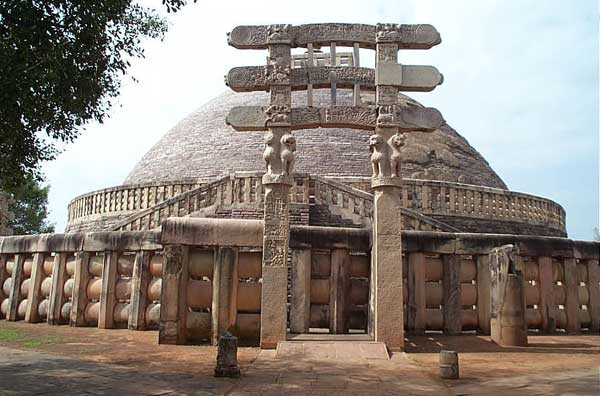
Emperor Asoka (273-236 B.C.) built stupas in Buddha’s honour at many places in India. Stupas at Sanchi are the most magnificent structures of ancient India. UNESCO has included them as one of the heritage sites of the world. Stupas are large hemispherical domes, containing a central chamber, in which the relics of the Buddha were placed. Sanchi stupas trace the development of the Buddhist architecture and sculpture at the same location beginning from the 3rd century B.C. to the 12th century A.D.
Asoka when he was a governor married Devi, the daughter of a respected citizen of Vidisha, a town 10 km from the Sanchi hill. Prince Mahendra visited Sanchi with his mother before leaving for the island of Lanka for taking Buddhism there. Emperor Asoka had put up at Sanchi a pillar edict and a stupa containing relics of the Buddha. Addition of new stupas and expressions in stone of legends around the life of the Buddha and the monastic activities at the Sanchi hill continued under several dynasties for over fifteen hundred years. Also, the Brahmi script could be deciphered from the similarities in inscriptions carved at different places in the main stupa.
Sanchi stupas are noteworthy for their gateways as they contain ornamented depiction of incidents from the life of the Buddha and his previous incarnations as Bodhisattvas described in Jataka tales. Sculptors belonging to different times tried to depict the same story by repeating figures. The Buddha has been shown symbolically in the form of tree or through other inanimate figures. One of the sects of Buddhism opposed depiction of the Buddha by a human figure.
The top of the Asoka pillar, which comprises of four lions, has been kept in the museum maintained by the Department of Archaeology. The size and the weight of the pillar point to advanced construction technology that was existent at the time of Asoka. It must have been an incredible feat of engineering to bring the stone for carving the pillar from the mine to Sanchi and installing it up the hill.
Jataka Tales
Jataka tales as do Aesop’s fables teach generosity and self-abnegation based on previous lives of the Buddha as Bodhisattvas. As a Bodhisattva he took births as man, animal or bird. It is believed that the Buddha accumulated virtue by good deeds he did as Bodhisattvas and had attained merit for achieving nirvana in his last birth when he was born as the prince Siddhartha.
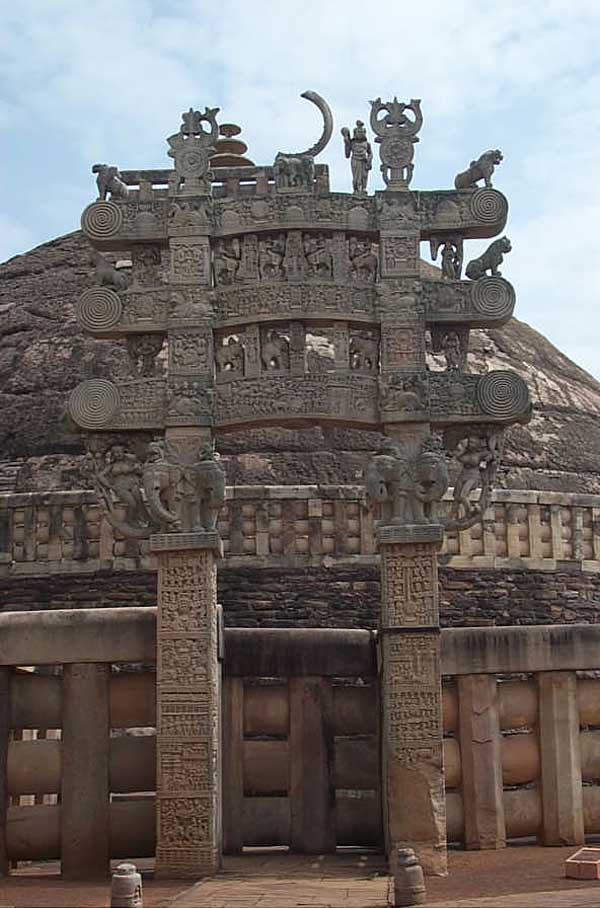
The Great Monkey Jataka
In this tale Bodhisattva was born as a monkey. He was the king of eighty thousand monkeys. They lived happily on a mango tree by the side of the river Ganges and ate its tasty fruits. Brahamadatta, the king of Varanasi, on knowing that the mangoes of the tree where the monkeys lived were very delicious and sweet, surrounded the mango tree with his soldiers. They started killing the monkeys with arrows. The monkey king at the risk of his life decided to save the lives of the other monkeys. He jumped across the river and found a bamboo pole. When he found that the length of the pole was not enough for crossing the river he tied one end of the bamboo pole to the mango tree and its other end to his waist. He stretched his body and made a living bridge across the river. His friends crossed to safety by using the bridge consisting of the bamboo pole and the stretched body of their king. Devadatta who was also a monkey was the rival of the monkey king. Devadatta found in this situation an easy opportunity for killing the monkey king. He jumped on him violently. The monkey king’s heart ruptured out of his body. When Brahamadatta saw the supreme sacrifice of the monkey king his heart filled with sorrow. The Bodhisattva before dying gave a sermon to Brahamadatta. Brahamadatta performed the last rites of the monkey king with honour and respect.
In some of the panels on the gateways of the stupa scenes from this Jataka tale have been shown.
Jataka Tales
Six-tusked Elephant Jataka
In one of his previous births the Bodhisattva was born as a six-tusked elephant. He lived in the Himalayas with his two female elephant wives named Chulasubhudha and Mahasubhudha . Chulsubhudha despised her husband as she thought that he loved his other wife more than her. She prayed that in her next life she may be born a beautiful girl and have the good fortune of marrying the king of Varanasi. Her deep jealousy and the desire to take revenge from her husband resulted in her death. As she had wished, she was born in her next birth a beautiful girl and became the wife of the king of Varanasi. She feinted illness and pleaded her husband to ask Sonuttar, the king’s archer, to bring for her the tusks of the six-tusked elephant. The hunter wounded the six-tusked elephant with arrows and tried to pull out his tusks. The elephant took pity on the hunter and helped him in pulling out his tusks. When the tusks were given to the queen she repented her wanton act and died out of grief.
In some panels on the gateways of the main stupa scenes from this tale have been shown.
Jataka Tales
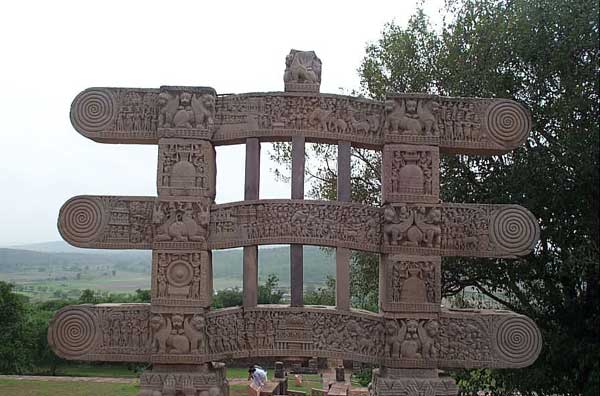
The Vessantra Jataka
In one of his previous births the Buddha was born as the prince Vessantra. The prince was very generous. He gifted away the elephant that had supernatural power of bringing rains to the Brahmins of Kalinga, as it was undergoing drought. Vessantara’s father, the king, was so upset by this gesture of his son that he ordered the prince to leave his kingdom with his wife, the son and the daughter. Vessantra drove out of his father’s country in a chariot driven by four horses. As he left, he gave away the carriage and the horses for asking, and settled in a hut in the forest with his family. Soon he gave away his children to a wandering ascetic, who needed them to do begging for him. Finally, he disposed off his wife in a similar manner. But all ended happily, for those who had asked him for his most precious possessions were gods in disguise, who had decided to test his generosity. They restored to him his family and Vessantra was received back by his father.
In some of the panels on the gateways of the stupa scenes from this Jataka tale have been shown.
Jataka Tales
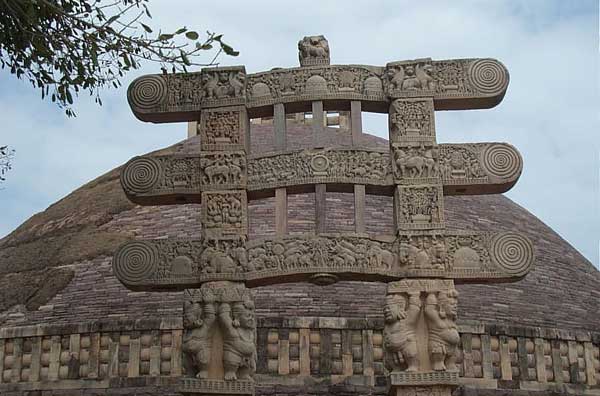
The Sama Jataka
This Jataka tale is about the extreme devotion of the Bodhisattva Sama to his parents. Sama’s parents had become blind because of snake bite. Sama devoted his life for serving his blind parents. One day when Sama was filling his pitcher with water from a river, the king of Varanasi miss took him for a deer and shot him dead with an arrow. When the king saw the pitiable condition of Sama’s parents his heart filled with remorse. The sorrowful king decided to dedicate his life in taking care of Sama’s parents. The lamentations of Sama’s parents and the noble gesture of the king touched the heart of a goddess who witnessed this situation. The goddess with her magical powers restored the eye sight of Sama’s parents and made Sama alive.
In some of the panels on the gateways of the stupa scenes from this Jataka tale have been shown.
Jataka Tales
An album of pictures from Sanchi has been put on this website. Individual pictures can be accessed from their thumbnails.


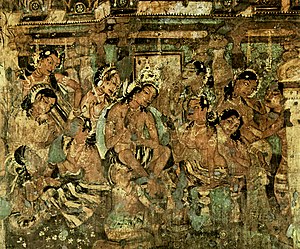

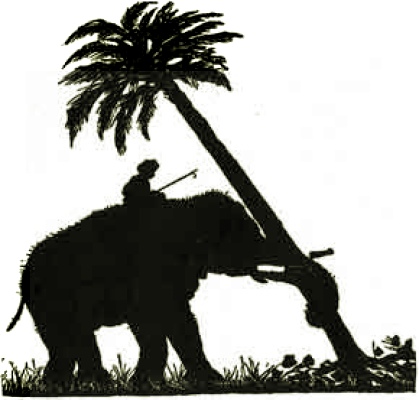
http://artfoundout.blogspot.com/2009/03/jataka-tales-scroll-from-thailand.html

Jataka Tales – scroll from thailand

 An Appeal - Many of the Indian artists mentioned on this site live in poverty. Even with the recognition they have received, most have not been able to find a place for themselves in the art market. The artists with the greatest needs are Ganesh, Teju and their children. They have no home to speak of and at times do not have money even for food. It may be impossible for most Westerners to truly comprehend the poverty that is their reality. You can help, simply by purchasing their work. I can arrange this and all the money will go directly to the artists.If you would like to collect their work, contact me at the e-mail listed on my profile.
An Appeal - Many of the Indian artists mentioned on this site live in poverty. Even with the recognition they have received, most have not been able to find a place for themselves in the art market. The artists with the greatest needs are Ganesh, Teju and their children. They have no home to speak of and at times do not have money even for food. It may be impossible for most Westerners to truly comprehend the poverty that is their reality. You can help, simply by purchasing their work. I can arrange this and all the money will go directly to the artists.If you would like to collect their work, contact me at the e-mail listed on my profile.


![[DSCN0337.jpg]](http://1.bp.blogspot.com/_WfpsDFzTM0A/SalqbtU3YaI/AAAAAAAACaQ/9rdSPFYG-Ws/s1600/DSCN0337.jpg)






 In northeastern Thailand, there is a tradition of scroll painting on fabric illustrating the Jataka Tales. These morality stories are of the previous lives of Buddha before he was born for the last time to become the Buddha.
In northeastern Thailand, there is a tradition of scroll painting on fabric illustrating the Jataka Tales. These morality stories are of the previous lives of Buddha before he was born for the last time to become the Buddha.
Due to tradition and climate issues, it is difficult to see scrolls that are over 50 years old. Scrolls were replaced when damaged or would be discarded (at times, burnt) when new ones were commissioned as gifts to a temple.
These scrolls are remarkable in their diversity of execution and hand. In a country with so many people trained to conserve and restore temple wall paintings, it is interesting to see that often these scrolls were the work of artists not instructed in a more formal manner.
Jataka Tales scrolls are often extremely long, at times over thirty feet in length and on average, three and a half feet wide. Many older works have not survived intact and it is common to see only fragments.
The examples on this page are of several different scroll fragments, presented to show the range of artistic style.
http://www.buddha-images.com/10jatakas.asp
The Jataka Tales - Previous Lives of the Buddha
The Jataka Tales are narratives about the previous lives of the Buddha (that is, before he was born for the last time to become the Buddha). In Thailand, the last 10 Jatakas (there are many, many more, a lot just involving animals) are often depicted along the longitudinal walls of temples. Thai mural paintings (both of the Jatakas, and of the Life of the Buddha) are often in various stages of disrepair. Almost all the paintings that are used as illustrations for the narrative of the 10 Jatakas below, are from Wat Yai Intharam in Chonburi province. Unfortunately, the Ubosoth of Wat Yai Intharam is not easily open to the general public. Some part of the paintings are likely a few hundred years old, some likely overpainted in subsequent years (not really sure, if anyone really knows exactly what is new and what is old).
All of the paintings follow certain rules in the composition of the images. There usually are some parts that make it easy to the believer or someone who has taken interest in Thai mural temple paintings, to recognize the particular Jataka in question. Going through the narratives, and the pictures shown, will make your next visit to a Thai temple much more interesting, since you will know what you are looking at.
The narratives (slightly modified) recounted come from the book : Ten Lives of the Buddha by Elizabeth Wray, Clare Rosenfield, Dorothy Bailey and Joe Wray (photography). Besides the stories here, this book, published first in 1973, gives a lot more information about the Jataka Tales in general, and Thai Temple Paintings. A reprinted softcover version is still available through Amazon.
The pictures in the book are different from the pictures on this website. All pictures accompanying the Jataka Tales by Guido Vanhaleweyk, Bangkok.
Temiya Jataka - Temiya, the mute Prince
There lived a king of Benares who, despite all his riches and plenty, still was unhappy. For though he had sixteen thousand wives, he had no son nor daughter. Each and every one of his wives prayed that she might bear a son to him. His main queen, Candadevi, asked of the great god Sakka : “If through my life I have done only good, a son be born to me.”
When her plea reached Tavatimsa heaven, the throne of Sakka, king of the gods, became warm, an sign of an injustice on earth. Sakka realized that he had overlooked the virtues of Queen Candadevi. Immediately, from among the deities in heaven he chose the Bodhisatta, who he knew would serve as a model of self-denial for the kingdom of Benares, and sent him down to earth to be conceived in the queen’s womb. In addition, to five hundred nobles’ wives he sent five hundred more beings to be born as the Bodhisatta’s attendants. When the queen felt as though her womb contained a diamond, she knew she was pregnant. She informed the king, and both were happy. Great care was taken until the day of her delivery. Upon hearing the words of the birth of his son, the new father felt paternal affection lighten his heart. At the same time, five hundred nobles’ gave birth to infants who were to grow up with the Bodhisatta and serve him. The Bodhisatta was given sweet milk from sixty-four wet nurses selected because of their flawless beauty. After presenting the nurses to the queen the king felt generous and told her he would grant anything she asked. However, the queen postponed her request, as she preferred to wait for the day when she might need it.
On the occasion of the naming of the child, the Brahmins proclaimed that the royal son and heir to the throne possessed every mark of good fortune. The king named his son Temiya-Kumaro, meaning ‘prince drenched with water’, because both his birth and the rainy day on which he was born were very wet.
When Temiya was only one month old, he was dressed up for his first public appearance and brought to the throne of his father to sit on his knee. Many courtiers admired his beauty and murmured their approval. Four robbers were then brought before the king to be judged. Temiya witnessed his father sentence one robber to a thousand strokes from thorn-baited whips, another to imprisonment in chains, a third to death by the spear, and a fourth to death by impaling. The infant Bodhisatta was terrified at his father’s apparent cruelty and thought to himself, “A king acts as judge, and so he must perform cruel actions every day. By condemning men to death or torture, he will however himself be condemned to hell.”
The next day, awakening from a short nap and looking up at the great white umbrella above him, the infant began to think of what it would mean to be king. These thoughts alarmed him, even more so as he remembered a previous existence in which he himself had reigned as king of Benares for twenty years. As a result of dread decisions forced upon him in the position of king, he had had to suffer eighty thousand years in hell. Now he was destined to become king again in the same city, again to suffer the same fate. This was more than he could bear. As he wondered if escape was possible, a goddess dwelling in the umbrella above him, who had been his mother in a former life, spoke to him :
‘Temi my child, let me help you.
You must do as I advise : Pretend to be a crippled mute.
Don’t move your limbs or use your voice. Then the people will refuse to crown you king and you shall be free.’
The Bodhisatta at once began to show signs of being different from the other five hundred children. While the others cried out for their milk, Temiya did not utter a sound. For the first year, his mother and nurses noticed with alarm that he neither cried nor slept, moved nor listened, though his body appeared normal. Knowing that he must feel hunger, they tried to force a sound from him by withholding his milk, at times by starving him for a whole day, but to no avail. In his second year, they tempted him with various cakes and sweets over which the other children fought. But Temiya would say to himself : ‘Eat the cakes if you wish for hell’, and thus abstained. All kinds of foods, fruits, and toys left him unmoved, though other children grabbed greedily for them.
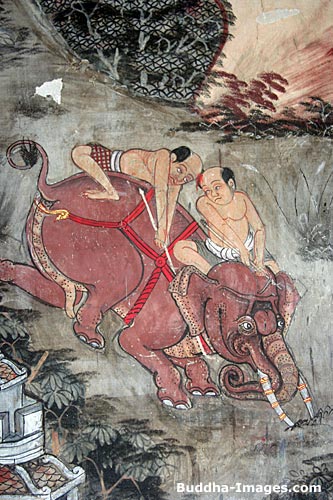 The Temiya Jataka -
The Temiya Jataka -
When Temiya (not shown in picture) was six years old, they set an elephant upon him, but Temiya unharmed and unmoved.
When he was five, they tried to terrify him into speaking. He was placed in the center of a house thatched with palm leaves. A servant was then ordered to set fire to it. Where normal children would have run away shrieking, the Bodhisatta remained motionless and sat quietly as the fire came closer to him, until he was taken away by his attendants. At six, they let an elephant loose at him ; at seven, they allowed serpents to coil about him. Still he remained unharmed and unmoved. In the following years, they showed him terrifying mimes, threatened him with swords, and made holes in four sides of a curtain around his bed and had conch players blast their sound through to him. They tried him with drums and sudden bright lamps in the middle of the night, but they failed to break his trance. Desperate, they covered him with molasses and allowed flies to cover and bite him, but he did not flinch. They forced him to remain unbathed, but his need for cleanliness did not overpower him. Pans of fire were placed under his bed, causing boils to break out on his body, but still he said to himself that hell was a hundred thousand times worse. His parents besought him to speak, to move, to listen, but he dared not.
At sixteen, when he would have been named heir apparent, they led him to a fumed chamber and tried to tempt him with beautiful maidens, but he stopped himself from breathing in order not to be weakened by the fragrances.
At last, the king summoned the soothsayers and asked them why at his son’s birth they had not mentioned any threatening signs of this affliction. Not understanding Temiya’s behavior but unwilling to admit their ignorance, they explained that they had not dared cast a shadow on the king’s joy when, after so many years, he had been given a son. But now, fearing for the safety of the country should an apparent idiot be named heir to the throne, they predicted dangers to the king’s life if Temiya were allowed to remain in the kingdom. Alerted by their words, the king asked what he should do. They advised him in this way: ‘You must yoke some horses to a chariot, send your son away in it, passing by the western gate, to a graveyard, and there he must be buried.’
When the queen heard of this plot, she knew the time had come to make the request which the king had promised years ago to grant. ‘Give the kingdom to my son’, she demanded. ‘For once he is crowned, he will certainly speak.’ The king protested. ‘Impossible, my Queen, for your son brings ill luck to us.’ Then give it to him for seven years’, she responded. Again the king refused. ‘Then for seven months’, she pleaded. ‘O Queen’, he said, ‘I dare not.’ “Then, alas, for seven days,” she sighed. “Very well.” The king relented. “Your wish is granted.”
And so it happened that Temiya was given the kingdom for seven days. He was led around the city, sometimes on an elephant, sometimes on men’s shoulders. Still he would not move either his limbs or his lips. On the seventh day, his mother begged him to speak, for on the day he was condemned to die. The Bodhisatta gravely considered her request, thinking to himself: “If I do not break my silence, my mother’s own heart will break ; if I do, I shall have wasted in one second what efforts I have made for sixteen years. Moreover, if I keep my pledge, my parents and I shall be saved from hell.”
Thus, Temiya again decided to be patient. For the day was near when he would be freed from the fear of inheriting the throne, and on that day, he would be able to speak. As the next morning dawned, the king gave his final orders to Sunanda the charioteer. “Yoke some horses to a chariot and set the prince in it. Take him out the western gate and find ground in which to dig a grave. After you have dug the hole, throw him into it and break his head with the back of your spade to kill him. Then scatter dust over him and make a heap of earth above. After bathing yourself, come back here.”
Sunanda took Temiya off, but though he thought he was passing through the western gate, the Death Gate, he did in fact drive to the eastern gate, which was the Victory Gate, and one of the chariot’s wheels struck the threshold. At the sound, the Bodhisatta knew he was on the threshold of attaining his freedom. By the power of the gods, a graveyard appeared. Sunanda stopped and removed Temiya’s royal ornaments from him, releasing him in one stroke from his yoke of royalty.
The Bodhisatta was at last freed from his vow, and as Sunanda worked at digging the grave, Temiya thought to himself, “In sixteen years, I have never moved my hands or feet. Can I do so now?” Whereupon he rose, rubbed his hands together, rubbed his feet with his hands, and alighted onto the ground, which at his touch became like a cushion filled with air. He then exercised his limbs by walking back and forth until he was satisfied that he had the strength he thought he had lost.
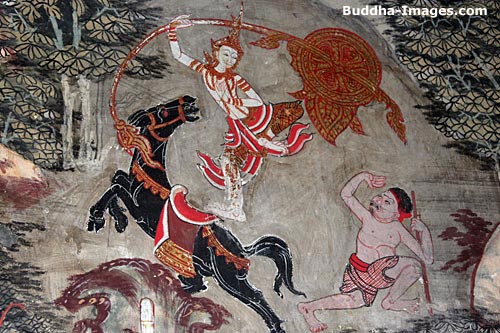 The Temiya Jataka -
The Temiya Jataka -
Temiya confirms his strenght by lifting a chariot.
This was his only chance to escape kingship and enter the forest as an ascetic, and the Bodhisatta wondered, was he powerful enough to overcome Sunanda if he tried to prevent his escape? As a final test of his strength, the Bodhisatta seized the back of the chariot and lifted it high with one hand as if it were a toy cart. Indeed, his power was confirmed. He walked over to the charioteer and tried to jolt him into looking at him with these words :
“Behold the man you seek to kill, not deaf nor dumb nor lame. Stop or bear the wrath of hell, for by this act you’ll die.”
Sunanda looked up but was so dazzled by the Bodhisatta’s beauty that he did not recognize him at first. Again Temiya identified himself. Suddenly Sunanda understood and fell at his feet, stammering that he would be honored to escort the prince home to inherit the kingdom. He who was destined for Buddhahood chided him, for nothing would deter him now from leading the pure meditative life. He described his previous existence and subsequent generations in hell and then ordered Sunanda to return to the palace immediately to tell his parents that he was still alive and thus spare them unnecessary grief over the loss of their only son.
As the charioteer approached the palace alone, the queen, who had been waiting by a window, saw him, assumed that her son was dead, and began to weep. But when Sunanda told her his story, she ceased. The king was told what his son had done, and he and the queen set out at once for the Victory Gate, hoping to lure the prince home.
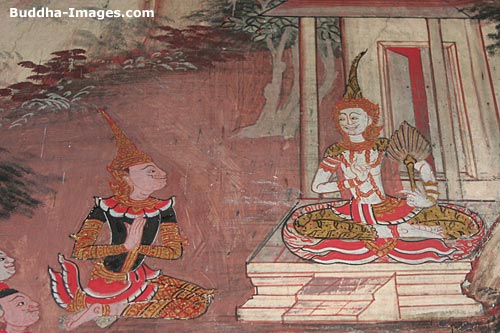 Temiya has become an ascetic and lives in the forest. He preaches to his father, the King, who kneels before him.
Temiya has become an ascetic and lives in the forest. He preaches to his father, the King, who kneels before him.
When the long procession of horse-drawn carriages came to a halt, the royal pair found their son living in a hut of leaves prepared for him by Sakka. They saw that he had already put on an ascetic’s garments of red bark and leopard skin, a black antelope skin over one shoulder and a carrying pole over the other. His hair was tied up and matted, and he held a walking staff in one hand. Temiya welcomed them and explained to them the reasons for his sixteen years of self-denial. In awe of their son, they no longer begged him to wear the crown but were themselves inspired to embrace the holy life. Returning to the palace, the king ordered the royal treasure jars to be opened and the gold to be scattered about like sand. Sakka built for the entire kingdom a hermitage three leagues long, so that all who aspired to Nirvana could partake of the meditative life.
Mahajanaka Jataka
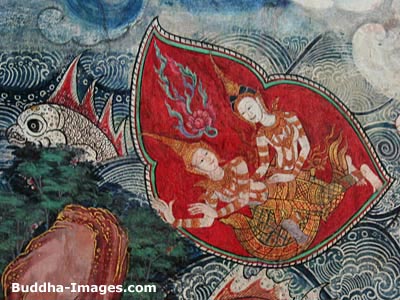 Mahajanaka Jataka.
Mahajanaka Jataka.
Prince Mahajanaka suffers a shipwreck. He struggles to keep alive swimming the ocean for 7 days untill the Gods came to rescue him. The scene symbolizes the virtue of Perseverance.
Wat Kongkaram, Ratchaburi
There was a king, Mahajanaka, of Mithila in the kingdom of Videha. He had two sons, Aritthajanaka and Polajanaka. When the old king died, the elder brother, Aritthajanaka, became king, and the younger brother his viceroy. In time the new king became suspicious of his brother’s popularity with the people and, fearful for his throne, had Polajanaka put in chains. But when Polajanaka proclaimed his innocence, miraculously his chains fell off and he was able to escape to a small village near the frontier of the kingdom. Since he was a strong leader, he attracted many followers.
In time he decided to take his revenge by declaring war on King Aritthajanaka. Before Aritthajanaka went to battle with his brother, he made his pregnant wife promise that should he be killed, she would flee from Mithila in order to protect the unborn child.
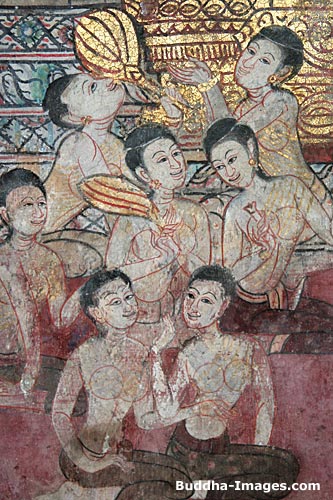 Scene from the Mahajanaka Jataka.
Scene from the Mahajanaka Jataka.
When she heard of the king’s death at the hand of his brother, Polajanaka, she gathered her gold and jewels into a basket and covered them with rice. She put on some worn and dirty garments and blackened her face with soot so that she would not be recognized. Then, lifting the basket onto her head, she went unnoticed out of the city by the northern gate. Now, the child in the fleeing queen’s womb was to be a Great Being, or Bodhisatta, and the attention of Sakka, king of the gods, was drawn to the queen’s plight. He therefore attired himself as an old man driving a carriage. On arriving at the queen’s side, he asked her where she was bound. She had in mind to go to the city of Kalacampa, sixty leagues away, but did not know the way. The disguised god offered to take her there, and after entering the carriage, the queen fell into a heavy sleep. By nightfall the carriage had reached the edge of Kalacampa. When the amazed queen asked how they could have reached the city so soon, Sakka told her that he had come by a straight road known only to the gods, then departed.
In Kalacampa, the unrecognized queen was observed by a northern Brahmin teacher of great fame. When he asked who she might be, she told him, “The chief queen of King Aritthajanaka of Mithila, lately killed in battle. I have come here in order to save the life of my unborn child.”
The Brahmin invited her to live in his house, saying that he would watch over her as if she were his younger sister. The queen agreed, and a short time later she gave birth to a son, whom she called after his grandfather Mahajanaka. He grew into a strong and sturdy child. However, he was often teased by his playmates and called “the widow’s son,” which name brought questions to his mind regarding his paternity. One day he went to his mother, threatening to bite off her breasts if she did not tell him who his father was. She was forced to reveal to him the secret of his birth-that he was the son of the former king of Mithila.
When the boy reached the age of sixteen, he determined to regain his father’s kingdom. He told his mother of his plan and she offered to give him her gold and jewels, which were sufficient to win back the kingdom. But he took only half of her gift, wishing to make his fortune in trade. She was alarmed for his safety, warning him of the dangers of the sea, but he was deaf to her words. After purchasing some goods for trading, he boarded a vessel bound for Suvannabhumi, the golden land of the east. On that day his uncle Polajanaka, king of Mithila, fell ill.
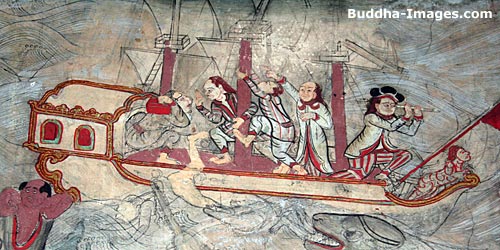 The Mahajanaka Jataka -
The Mahajanaka Jataka -
Mahajanaka suffers a shipwreck.
Crowded on board were the men and animals from seven large caravans. After seven days of plunging through the heavy seas at top speed, the overloaded ship began to founder. Planks broke off, and the water rose higher and higher. Mahajanaka, knowing that the ship was sinking, did not panic. He prepared himself for the ordeal by eating a full meal, covered himself with sugar and ghee to protect himself from the water, then tied himself to the mast. When the ship went down, men and animals were devoured by the sharks and fierce turtles that infested the ocean, but the mast remained upright. Mahajanaka with his superior strength was able to throw himself a far distance from the ship, thus escaping the fate of the other passengers. On that day Polajanaka died, leaving the throne of Mithila vacant.
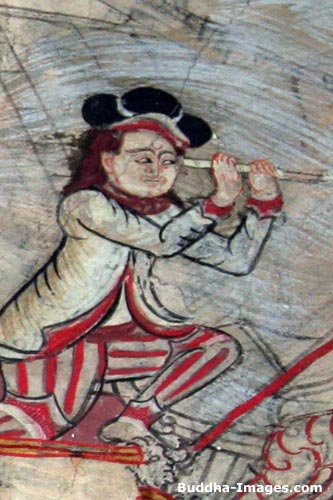 The Mahajanaka Jataka -
The Mahajanaka Jataka -
Notice that the crew includes some foreigners, a common feature in Thai mural paintings.
Mahajanaka floated in the ocean for seven days, taking no food. During this time the goddess Manimekhala was enjoying the pleasures of heaven, neglecting her duties as guardian of the seas. At last she spied him and recognized that he was not an ordinary mortal. She took him in her arms, and Mahajanaka, thrilled by the touch of the goddess, fell into a trance. She flew with him to a mango grove in the kingdom of Mithila, where she laid him on his right side on a ceremonial stone in the middle of the grove.
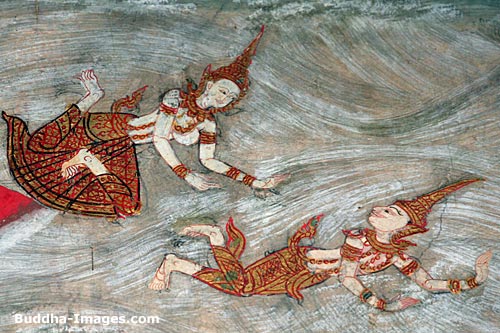 The Mahajanaka Jataka -
The Mahajanaka Jataka -
Mahajanaka is saved by the Goddess Manimekhala.
From his deathbed, the king of Mithila had told his ministers that to find a man worthy of being king, they must look for one who could answer certain riddles, who could string the king’s powerful bow, and who could please his daughter, the beautiful and intelligent Princess Sivali. There were many candidates for the throne. Each one, in an effort to win Sivali, obeyed her every whim. The more they tried to please her, the more she scorned them and sent them away. Moreover, not one had the wit to answer the riddles or the strength to string the royal bow.
At last the ministers decided to send out the festive chariot to see if they could find a successor to Polajanaka. They decorated the city, yoked four noble steeds to the handsome carriage, and bade the musicians follow behind as is proper when a royal chariot is empty. Then they ordered the carriage to lead them to the one who had sufficient merit to be king of Mithila. Followed by a great crowd, it took them through the city to the eastern gate and onward to the park where Mahajanaka lay sleeping. After circling the stone, the chariot came to a stop. The ministers observed the sleeping prince and examined his feet, whereby they recognized the signs of royalty. Indeed, they saw that he was not only a future king but also destined to be emperor of four continents. They commanded the musicians to sound their instruments. At the noise, Mahajanaka awoke. Seeing all the people around him, he recognized that the white umbrella of kingship had come to him. He asked where the king might be. When told that he had died, he agreed to accept the kingdom.
Meanwhile, Princess Sivali was waiting. However, when the new king arrived he did not visit her or pay her any attention. One day when he was strolling in the garden, she could bear his indifference no longer. Running up to offer him her arm to lean on, she showed that he pleased her. Shortly thereafter she became his queen.
King Mahajanaka answered the riddles with ease. He was also able through his great strength to string the bow of King Polajanaka, so that he fulfilled all the conditions for becoming king. Wisely and well he ruled for seven thousand years. His wife Sivali bore him a son and heir to the throne.
One day the king was riding through his kingdom with his ministers when he observed two mango trees. The one that had been full of mangoes was broken and torn by the people who had come to pick the fruit, while the other, though barren, stood green and whole. Thus he came to understand that possessions bring only sorrow, and he determined to put aside his kingdom and take up the life of an ascetic. After shaving his head and putting on the robes of a hermit, he departed from the palace. But Queen Sivali, who loved him, followed him with great retinue. Wherever he went, she was behind him. At last he could bear it no longer. He cut a stalk of grass and said to her, “As this reed cannot be joined again, so you and I can never be joined again.”
At his words, Sivali fell down to earth. While the courtiers were attending to her, Mahajanaka disappeared into the forest. When the queen awoke, she could find him nowhere. He was never again seen in the world of men, for he found his way to the Himavat forest and eventually entered the Brahma heaven.
The despairing queen returned to Mithila and arranged for the coronation of her son. Having settled the affairs of the kingdom, she herself donned the robes of a hermit, and after many years she too was deemed worthy of entrance into the kingdom of the gods.
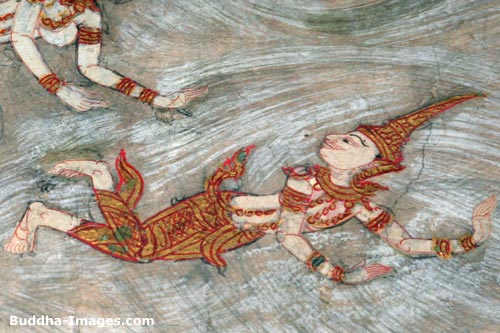 The Mahajanaka Jataka -
The Mahajanaka Jataka -
Mahajanaka looks up to his saviour, the Goddess Manimekhala.
Unless otherwise specified, all images from Wat Yai Intharam, Chonburi
Sama Jataka - Sama, the devoted Son
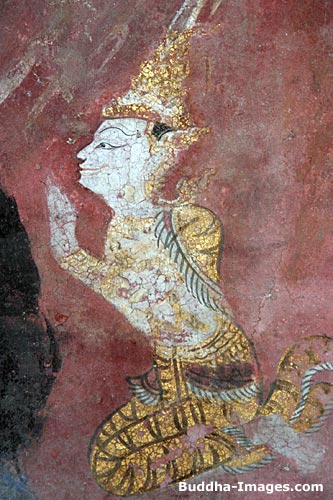 The Sama Jataka -
The Sama Jataka -
King Piliyakka
Two villages were situated on opposite banks of a river dividing the Kingdom of Benares. Their hunter chiefs, friends throughout the years, betrothed their infant children to each other shortly after their birth. Now, these two were not like other children. Both were born with skins of golden hue. And although they were surrounded by hunters, they refused to harm any living creature. They had a special destiny, for they had to replace with purity and goodness an evil carried with them from a former life. At that time, many lives ago, they had been born into the family of a doctor who, angered by a rich patient’s refusal to pay his fee for curing the eye disease, gave him some medicine which took away the sight of one eye. Though the evil was done by the head of the household, the children of the family also had to do penance. Thus it was that, once they were born into families of hunters and betrothed, they felt obliged to live as ascetics and deny themselves all pleasures of the senses. In vain each begged his parents to forgo the marriage. They were married against their will, but secretly determined to live as brother and sister.
Dukulaka, as the boy was called, and Parika, the girl, unwilling to hunt or partake of the comforts of their parents’ dwelling, were allowed to go into the forest and live in an hermitage where they led lives of meditation and purity. Although Sakka helped them with their small needs, he was uneasy, for he knew that their past had not yet been washed clean. Sakka foresaw that a grave misfortune was to strike them. He tried to convince them that they would have to bear a son in order to be assured of someone to care for them when affliction struck. “Never,” they said. “Impossible.” For this was not the way of asceticism. At last Sakka persuaded them that a pure conception could take place if, at the proper time, Dukulaka placed one finger on his wife’s navel.
So it was that the Bodhisatta was reborn into the world of men. But it was not quite a human world. As the ascetics came and went, looking for berries and nuts in the forest, it was a graceful kinnaris who looked after Suvannasama, or Sama, as the Bodhisatta was named at birth. This holy life could only have taken place in the Himavat forest, below the peaks that reach into the very palaces of the gods in Sakka’s heaven. And yet, its inhabitants were not immune to danger. When Sama was sixteen, as predicted, a misfortune befell his parents. As they were making their way home after a day of gathering fruits, it suddenly began to rain. Taking shelter at the roots of a tree, they unwittingly stood on an anthill under which a poisonous snake resided. As they huddled there, drops of their sweat fell onto the snake and he was angered. So he puffed out his deadly breath at them and blinded them instantly.
From this time onward their son, whom they grew to cherish even more than before, was their sole support. Sama tied ropes and bamboo poles in all directions for them to follow. He swept their dwelling clean of leaves and insects, collected their food, fed them succulent fruits, went every day to a pond to fill a waterpot for them. He bathed them and comforted them. He moved about so gently that even the deer, timid of other men, were never afraid of him and accompanied him wherever he went.
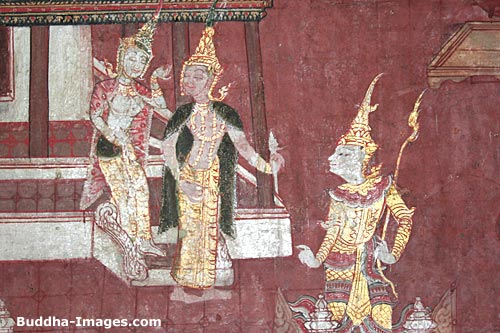 The Sama Jataka -
The Sama Jataka -
King Piliyakka takes leave from his companions to go hunting in the forest.
One evening, while Sama was fetching the evening’s water in his small round pot, which one of the deer that accompanied him used to carry for him, the king of Benares himself wandered into the forest. While hunting for venison, he had chanced upon a glade near the pond where Sama stood. The king, named Piliyakka, was fascinated by the sight of what appeared to be some divine creature for his ability to tame the animals of the forest. He was consumed with curiosity and the desire to take a trophy home to show his ministers. Envisioning the reception he would enjoy once he returned home with such a prize, Piliyakka in his pride drew back his bow and shot a poisoned arrow into Sama’s side. The deer fled in terror. The waterpot tumbled over. And Sama slowly and gravely sank to the sand. Blood poured from his lips as he spoke aloud, asking who it could be who desired his death and what could be gained by such an act.
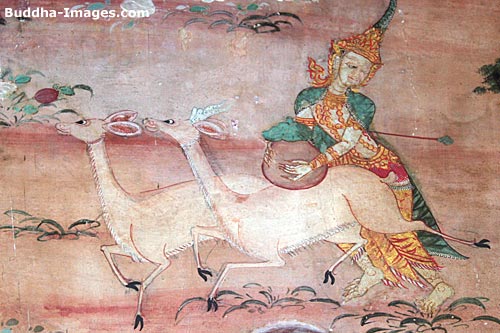 The Sama Jataka -
The Sama Jataka -
Sama is shot by an arrow in his side by King Piliyakka
King Piliyakka was struck by the absence of blame or anger in Sama’s words and ventured out of concealment. As they talked, the king pretended that he had been aiming at one of the deer rather than at Sama. But Sama knew this to be a lie, and Piliyakka had to admit the truth. Still the boy did not reprimand him. Instead, he grieved aloud for his parents. Who would feed them now? Who would bring them water each day? Who would bathe them? The king was struck with shame. Whereupon he took up the waterpot and promised Sama to care for his parents as if they were his own. Sama then lost consciousness. Piliyakka, thinking he was dead, wailed loudly and paid homage to Sama’s body.
In the meantime, a daughter of the gods who had been Sama’s mother in his seventh incarnation before this one sensed that something had befallen her former son. Convinced that Sama as well as his parents would die if she did not intercede, she proceeded to the scene and, hidden in a tree, spoke to the king, who had already begun to change his mind about caring for Sama’s parents. “O king,” she admonished him. “You have done a grievous thing. Go and nurse the blind parents and your bad deed shall be forgotten. Be charitable of heart and you will attain heaven.”
Inspired by the goddess’s words, Piliyakka set out for the hermitage. There he confessed his crime to Sama’s parents. They were stricken with sorrow and grief. So great was their suffering that their penance, carried with them throughout so many lifetimes, was at that moment ended. Unaware of their renewed purity, they asked merely that the king lead them to their son’s body. The king reluctantly complied.
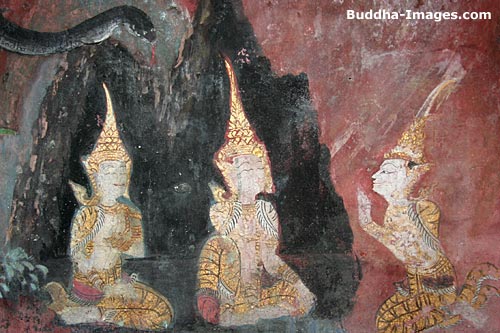 King Piliyakka informs the parents of Sama of their son’s death. Notice the snake on top (see story)
King Piliyakka informs the parents of Sama of their son’s death. Notice the snake on top (see story)
On reaching their son, the two ascetics knelt down and wept. All past evils having been washed away by their tears, they were able to bring their son back to life. As his mother prayed, Sama’s body slowly turned to one side. As his father took up his mother’s solemn words, he turned to the other side. The goddess, who had witnessed these acts from her hiding place, then revealed herself and profoundly asserted the virtue of Sama. The air was tense. Even the kinnaris who had cared for Sama as a child gathered quietly to wait for a miracle to happen.
Through the night they remained beside him, all minds bent on restoring life to the boy who seemed more a heavenly being than a human. At last Sama stirred, then rose, fully recovered from his injury. At that very moment, dawn broke over the forest and Sama’s mother and father could see with their own eyes Sama’s restoration, for their blindness had ended along with their penance. King Piliyakka, who had come as an intruder into this quiet and pure world, left the site, full of wonder and amazement at the miraculous event he had witnessed. He was unaware to the last that even he had served as an agent of good, for without his cruel act, the devoted son Sama could not have ended his parents’ affliction.
Nimi Jataka - Nimi, the noble King
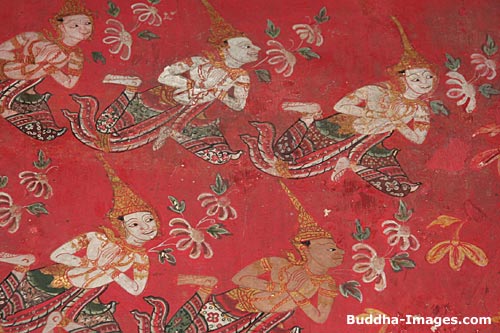 The Nimi Jataka -
The Nimi Jataka -
Flying Devas in Heaven. They pay respect to Nimi. The falling three-petaled flowers symbolize the conferring of blessings, and are typical in paintings from the Ayutthaya period.
Once there lived a king named Makhadeva, who upon spying his first gray hair told his barber to pluck it out and put it in his hand. When the barber asked him why, he replied solemnly, “This gray hair is a messenger from the heavens. Four and eighty thousand years I have passed as a youth. Four and eighty thousand years I have been king. The time has come for me to renounce my throne and the worldly life, and to live the life of an ascetic eighty-four thousand more years.” True to his word, King Makhadeva handed his kingdom over to his son, charging him to be alert to his first gray hair so that he too could take up the hermit’s life and give the kingdom to his own son. And so it happened. Son after son after son of the line of King Makhadeva reigned until the sign of the first gray hair, then exchanged kingship for asceticism and, like their forefathers, upon death entered the heaven of pure intellect, Brahma’s heaven.
Eighty-four thousand generations minus two passed, and King Makhadeva, from his place in Brahma’s heaven, was pleased that all his descendants had followed his example. Then he pondered, “Will any of us attain Nirvana now?” He perceived that the state of nonbeing was not within the reach of any of his line. This being the case, Makhadeva resolved to round off his family line by coming to earth again as the son of his descendant the present king of Mithila. In this way he would be reborn as a king, bear one more son to whom he would give his throne, and become an ascetic once again. Then, after his death, he would watch his childless son turn to the holy life and finally end the cycle of Makhadeva’s family.
When Makhadeva descended from Brahma’s heaven, he was born as a Bodhisatta, and the soothsayers correctly foresaw that he was meant to round off his family. Hearing this, the king named his newborn son after the hoop of a chariot wheel. The Bodhisatta was called Nilni-Kumara, or Prince Hoop. According to tradition, when his father caught sight of his first gray hair young Prince Nimi became king.
As king, Nimi was faultless, ruling by example, giving alms, caring for the poor as if they were his own kinsmen, and observing in earnest the holy days. Indeed, he inspired many of his people to lead such good lives that upon death they reached the realm of Sakka’s heaven.
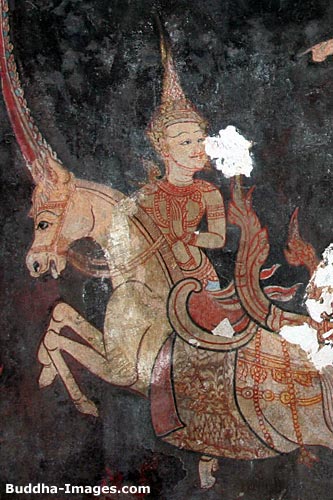 The Nimi Jataka -
The Nimi Jataka -
Matali, the Charioteer, guiding Nimi on his visits to Hell and Heaven.
Now King Nimi, like all truly good men, was not satisfied with himself and yearned to know the answer to one great question: which is more fruitful, the holy life or faithful almsgiving? So strong was his desire to learn the truth that Sakka’s throne became warm and the king of the gods sped in person to Nimi’s chamber. The palace became like a fiery light as Sakka entered and explained : “Good King Nimi, I have come to help answer your question. The holy life, in which a man lives as an ascetic, is by far the more fruitful, for by meditating he can go beyond my heaven, where we gods still have senses and feelings, to Brahma’s heaven, where only the intellect remains, and sometimes beyond that, to Nirvana. Nevertheless, almsgiving to all, regardless of caste, is right and befits a great man and a king such as you, King Nimi.” Without further delay Sakka departed, leaving Nimi pondering his words.
When Sakka reached his home, Tavatimsa heaven, he described at length the good and pious King Nimi to the deities. They were overjoyed to hear of him, for some of them were former subjects of his, and they cried, “Let us see him ! We wish to look upon him again, for at one time from his very own lips we received his teachings, and through his example we attained Godhood.” They persuaded the great Sakka to agree.
And so he ordered the divine chariot to appear and be readied for a journey to earth. Matali the charioteer was called upon to guide the chariot, pulled by one thousand thoroughbred steeds, to earth to bring King Nimi back to heaven to stand before the gods.
On the festival of the full moon, after traveling earthward for many days, the chariot appeared over the city of Mithila in the kingdom of Videha, whose people were still celebrating though it was late at night. Catching sight of the celestial chariot as it shone above their heads in the sky, they marveled at it and wondered what it might be. A second moon? A sign from heaven on this festival day? When they saw that it was a chariot, they realized that it must be Sakka’s own vehicle come to their king, whose righteousness had caught the eye of the gods.
Matali guided the chariot to the eastern window of the palace, where King Nimi was seated contemplating; and as the moon rose in the east, Matali called out, “King Nimi! The deities of Sakka’s heaven are well pleased with you and are longing to see you. I am sent by the King of the Gods himself to escort you to his realm.”
King Nimi accepted graciously, but before entering the chariot, he told his people that he would not be gone long. As they rose into the sky, Matali asked him which road he would like to take first, the one to heaven or the one to hell. Nimi, knowing that whatever befell him, he would always be able to see heaven, chose the road to hell, saying, “Take me first to the bowels of the universe, to hell, where the condemned dwell.”
Matali plunged the chariot into the blackness of the various worlds of hell. Fires blazed, and soon they saw below them the burning River Vetarani, covered with brine that erodes the flesh, emitting the most fetid odors, and filled with struggling sinners. Nimi wept to see such suffering and cried out to Matali, “0 Matali, what did those men do to be cast into such a river?” Matali told him in what ways they had been cruel and how their wrongdoing had begotten other evils.
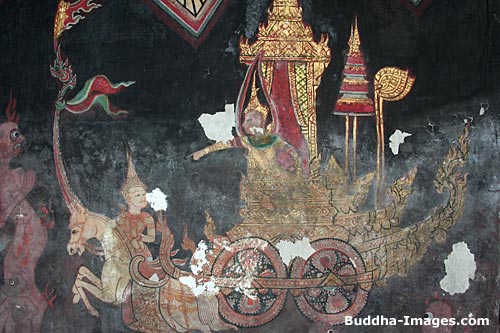 The Nimi Jataka -
The Nimi Jataka -
Nimi visits Hell and points to the creatures suffering in it.
Then Matali made this river disappear and summoned the next hell to appear, where misers and men who had been selfish with ascetics and Brahmins were being torn by black dogs, crows, and vultures. Nimi shook and shuddered to see still another hell where those who had tormented other people were being pounded with hot lumps of coal, and another where perjurers and debtors struggled to climb out of a fiery pit. At the sight of the hell where animal haters struggled head-down in iron caldrons filled with boiling water or fire, Nimi was filled with fear and horror.
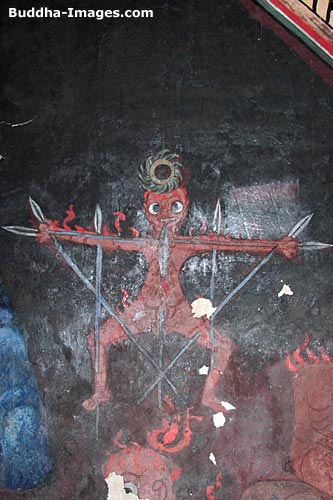 The Nimi Jataka -
The Nimi Jataka -
Scene of torture in Hell. Spears and arrows are reserved for thiefs and cheaters.
But Matali was unrelenting. He was determined to show Nimi all the hells : the one where dishonest grain sellers lay prostrate with heat, having been given water which instantly turned to chaff as they drank ; the one where spears and arrows were plunged into the sides of men who had stolen and cheated others; the one where animal slayers were torn to shreds. Farther on, Nimi had to witness malicious men being forced to eat filth and garbage and those who had committed patricide and matricide drinking from a river of blood. Still farther on, greedy hagglers struggled like fish on hooks which pierced their tongues. Adulterous women wailed and waved their arms hopelessly, their upper halves in flames, their lower halves buried in mud. Still others strained endlessly to climb out of hell’s windows, only to fall again and again. And Nimi grieved for them all that their evil deeds had brought them to this.
Meanwhile, the deities in Sakka’s heaven wondered why Nimi was so long in coming. “Matali is wasting Nimi’s lifetime visiting all the hells,” they cried. “Tell him to hurry.” Sakka sent a speedy messenger down to hell. When he finally reached them, he called out to Matali, “Show the king all the hells at once, that this visit be ended straightaway. The gods are impatient and are afraid you are using up Nimi’s lifetime.” Thus Matali opened all the worlds of hell to Nimi’s sight, then turned the chariot heavenward and rushed the shocked Nimi away, his mind dazed by the horrors he had witnessed.
Swiftly the vehicle rose, passing heavenly mansions of great beauty, allowing Nimi to catch brief fragrances of gardens which perfumed the air, to glimpse crystal palaces which sparkled like gems, and to hear strains of cool celestial music sung by sweet nymphs and birds. To Nimi, each heavenly abode seemed more beautiful than the last, and at each he engaged Matali in conversation, asking, “What good did this mortal do in his earthly existence? Who was he that he attained such a celestial state?” Matali explained that the man who lived in seven mansions with his wives had in his lifetime given seven hermitages to seven hermits, that the women who dwelt in palaces of crystal with hundreds of columns, bells and banners, flowers and lakes, had been women who had always kept the holy days. He described how still others, who lived in mansions of gems filled with heavenly musicians playing lutes and singing, had fed holy men and provided their cities with parks and wells.
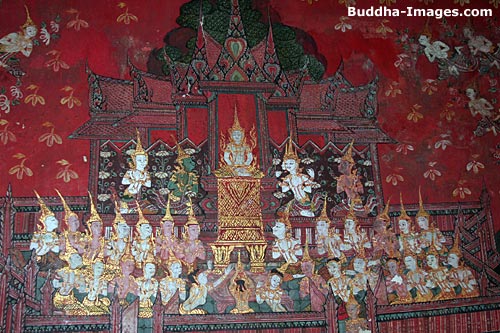
The Nimi Jataka -
Nimi preaches to the Devas in Tavatimsa Heaven.
See larger version of this picture.
Once again, Matali’s thoroughness in answering Nimi’s questions annoyed the deities in heaven until they pressed Sakka into sending yet another swift messenger to hurry them along. “No more delay,” cried the messenger. “Show Nimi all the heavenly mansions at once.” After Matali opened up the heavens to Nimi’s vision, he urged the horses on faster and faster.Upward the carriage rose, past the seven hills surrounding Mount Sineru, past the heaven of the Four Great Kings, until at last, within sight of the huge statues of Sakka himself that framed the Cittakuta gateway to his heaven, Matali slowed the chariot with its one thousand steeds to a halt. As he led the chariot to a side platform on which he could land, Matali pointed out the eight-sided columns made of rare gems that supported the palace and announced to Nimi, “This is Tavatimsa, the heaven of the thirty-three ; here the gods assemble, all thirty three of them, with their master Sakka, the king, who looks after men and gods alike, permitting some to enter his heaven, others to remain, sending still others to hell. It is a beautyful and most sensual place, 0 King, as you shall see.”
As they alighted, the deities ran to the gateway to greet Nimi with flowers and perfumes. The mighty Sakka begged him to be seated on his own throne and to stay to enjoy the delights of his heaven. Nimi, however, replied that he came not for unearned pleasures but for discussion of the moral precepts. For seven days Nimi charmed the company of heaven with his discourse, and at the end of that time, he again refused Sakka’s invitation to remain. He felt that his people needed him. “Now I must depart,” he said. “My subjects await me.”
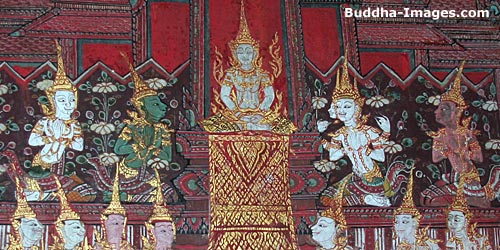 The Simi Jataka -
The Simi Jataka -
Simi preaches to the Devas - Detail.
Once again the chariot was prepared and Matali summoned. Nimi bade the gods a friendly farewell and began his journey back to Mithila. When the chariot came in view of the city, the people again looked up wonderingly. Then, recognizing their king within it, they cried out with joy. Matali drove the chariot around the city once, put Nimi down at the eastern window of the palace, and departed for Sakka’s realm. As King Nimi the Bodhisatta alighted, his subjects surrounded him and questioned him. Nimi told them of the wonders he had seen and of the peaceful existence of all who dwell in heaven. He also told them of the horrors he had witnessed in the underworld.
“Do good,” he advised them. “Be charitable and of a pure heart, and you shall be reborn someday to such a heaven. Some of this kingdom’s own people did I see there who, having done good in this city, have become deities in Sakka’s heaven. All of you can attain that. But beware of evildoing, for I have seen in the worlds of hell more suffering and torture than my tongue can describe.”
Years later, when the king’s barber showed Nimi his first gray hair, Nimi knew it was time to give his kingdom to his son. From then on, he lived as an ascetic in a mango grove at Mithila and upon his death surpassed Sakka’s heaven to enter the Brahma heaven, where all is mind and wisdom. Thus it was that Nimi, as the Bodhisatta, rounded off King Makhadeva’s line and with the death of his son ended the cycle in the four and eighty thousandth generation.
Mahosadha Jataka - Mahosadha, the clever Sage
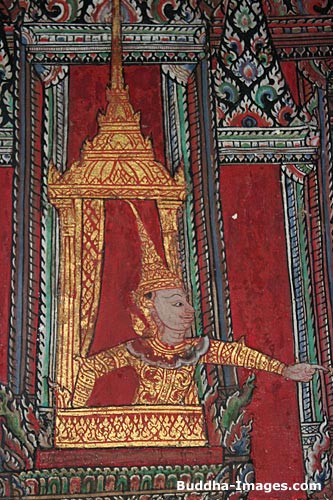 The Mahosadha Jataka -
The Mahosadha Jataka -
King Vedeha, in his palace, laments the attack on his Kingdom
In the Kingdom of Mithila ruled a king called Vedeha, who was instructed in the ways of the law by four sages. At dawn one morning the king was awakened by a fantastic and frightening dream. His whole world had been illumined by fire which rose in four columns from the corners of the world. Suddenly in the center a fifth flame arose, which was at first only the size of a firefly. As King Vedeha watched, the fifth flame grew in height and glory until it encompassed all the other pillars of fire. At the same time multitudes of people passed through the flames without harm. Terrified, the king consulted his sages about the meaning of such a scene. The four wise men interpreted the dream to mean that a fifth sage would soon appear who would surpass them all. They themselves represented the four original columns of fire, and they saw in the dream their fame consumed by the growing splendor of the fifth and central flame. And, in fact, on that day a Bodhisatta, or future Buddha, was conceived in the womb of Lady Sumana, the wife of a wealthy merchant in the market town at the east gate of Mithila. At the same instant, a thousand other sons of the gods were conceived in the families of other rich men so that the Bodhisatta would be properly attended.
Nine months later, the Lady Sumana brought forth a child the color of gold who was called Mahosadha. In his hand he clasped a medicinal herb which caused a painless birth for his mother and which cured all the sick who had gathered to see this marvelous infant.
Throughout his childhood Mahosadha grew in wisdom. At the age of seven he demonstrated the architectural talents which would later save both his kingdom and his king from destruction. He built a great hall with many rooms and surrounded it with lakes covered with lotus blossoms. There he would sit dispensing advice to petitioners who needed aid. And his childhood was a happy and peaceful time in all the kingdom, for a Bodhisatta had made his appearance.
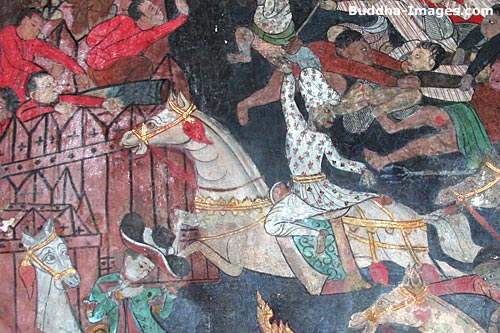 The Mahosadha Jataka -
The Mahosadha Jataka -
Battle Scene.
Recalling his dream, King Vedeha decided to fetch Mahosadha to his court. The four sages were sent to find him, but they too remembered the prophecy and were reluctant to hasten their own fall from authority. They were so overcome with jealousy that they plotted ceaselessly to keep the Bodhisatta away. Each sage devised trials and riddles intended to prevent Mahosadha from reaching the king’s presence. However, the boy solved whatever was set before him with great cleverness and at last had to be admitted to the court.
For many years Mahosadha instructed the king in matters both spiritual and temporal. At the same time, he had to be on guard constantly against the devious tricks of the old sages. However, he was able to thwart their jealous maneuvering and firmly directed King Vedeha into proper behavior, despite the king’s childish tendency to believe whatever he was told and to obey his impulses regardless of’ the consequences.
During these years one hundred and one kings of India united under the leadership of a wicked sage called Kevatta and set out to conquer the whole of India. However, Mahosadha had not been idle. He had rebuilt Mithila’s defenses and had sent spies to live among Kevatta’s men, so that he was prepared to meet each challenge as it arose. When the kings laid siege to Mithila, Mahosadha was ready.
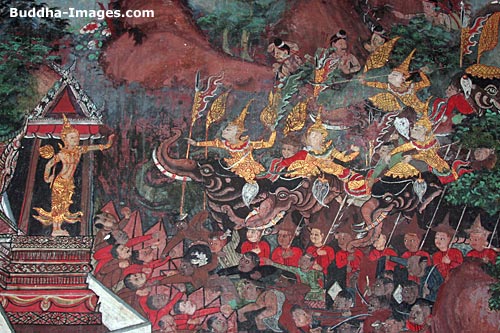
Mahosadha confronts the attacking Indian armies, led by King Culani. Notice that one hand of Mahosadha holds a monk’s fan.
See enlarged version of this image.
As the mighty forces approached the city, they were greeted by sounds of a festival in progress. Dismayed by the inhabitants’ apparent lack of fear, the kings conferred and determined to cut off the water supply. Mahosadha responded by causing huge fountains to be built, and water flowed out of the city in prodigious quantities. Realizing that Mithila must have deep wells and vast stores of water, the kings next attempted to starve the city into submission. Whereupon Mahosadha had huge amounts of food dropped over the walls, saying that Mithila had more than it could use. Perhaps the enemy army might be hungry. The hundred and one kings were astonished. They determined to stop all fuel from entering the city, but once again they had no success. Mahosadha caused great pyres of wood to be burned in the moats surrounding the walls, demonstrating that he had an enormous surplus of fuel.
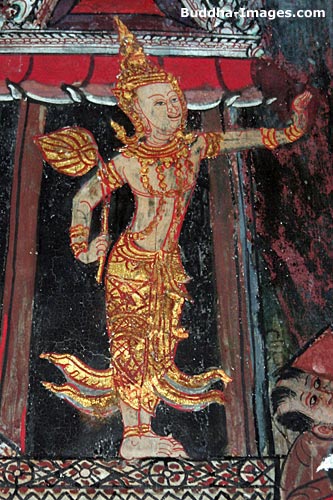 The Mahosadha Jataka -
The Mahosadha Jataka -
Mahosadha confronts the attacking Indian army. Detail.
The kings redoubled their efforts to take the city, but to no avail. Mahosadha, watching from the ramparts of Mithila, anticipated their every effort to gain access to the city. Finally, near despair, Kevatta thought of a last ruse: “We shall meet outside the gates,” he proposed, “and Mahosadha will have to salute me, for I am by far the elder. We know that whoever does obeisance is conquered. This is one contest he cannot win.” Mahosadha instantly realized the implications of this challenge and devised a trick which would thwart the wicked Kevatta once again. Having learned from his spies of Kevatta’s surpassing greed, Mahosadha advanced outside the city gates carrying an octagonal gem which glittered enticingly in the sunlight. Pretending to offer it to his enemy, Mahosadha dropped the jewel into the dirt. Kevatta immediately lunged to retrieve it. As he knelt on the ground, Mahosadha held Kevatta’s shoulder blades with one hand and his back with the other so that the grasping sage could not stand up. Holding him thus, Mahosadha shouted loudly, “Rise, teacher, rise! I am younger than you, young enough to be your grandson. Do you no obeisance to me!” Hearing these words, the hundred and one kings and their armies became frightened. If Kevatta had made obeisance to Mahosadha, then they were indeed lost. Without stopping even to retrieve their weapons, they fled.
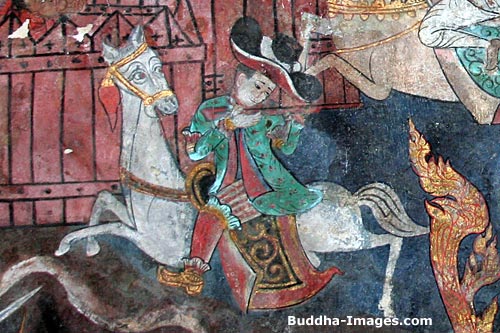 The Mahosadha Jataka -
The Mahosadha Jataka -
Notice the Western participants in the fighting
Furious at his humiliation, Kevatta withdrew to the city of his king, Culani, in order to devise a new plan for defeating Mahosadha and King Vedeha. Finally he perfected a scheme for luring the king into his power. King Culani had a beautiful daughter. Her portrait, along with poems describing her beauty, was sent to Mithila and presented to the gullible King Vedeha. Soon befuddled with passion, King Vedeha determined to have her for his bride. Despite Mahosadha’s warnings of trickery, Vedeha stubbornly persisted in his foolishness and began to plan his journey to Culani’s kingdom. At last Mahosadha decided that he would have to save the king in spite of himself. Obtaining permission to go to Culani’s city four months in advance of Vedeha, he immediately set about outwitting Kevatta and King Culani. With his architectural genius, he proceeded to construct a splendid palace for King Vedeha on the outskirts of Culani’s capital. This was no ordinary palace, for within it was the entrance to an underground tunnel filled with marvels never before seen by man. Embellished like a hall of the gods, its walls were covered with rich paintings and tapestries. Hanging lamps illuminated the passages, which were divided by eighty great doors and sixty-four small, all opening and closing at the touch of a finger. These led into a hundred and one bedchambers, similarly adorned and decorated with statues of beautiful women. The marvelous tunnel led to the royal palace where Culani’s daughter lived and ended in a cave on the mouth of the Ganges river, some distance outside the city walls.
When all was ready, King Vedeha arrived at Culani’s city, only to discover that he was in danger of his life. Waiting inside his new palace to receive his bride, he became aware of ominous numbers of Culani’s troops gathering outside. At first he only questioned his four old sages, for he was ashamed to ask Mahosadha’s advice after disregarding him completely. Each sage in turn shook his head in dismay and counseled suicide as the only alternative to slow death at the hands of the enemy. Finally Vedeha turned to Mahosadha and frantically begged for his help. For a time Mahosadha demurred, pretending that he was powerless, for he wished to impress the king’s folly upon him. At last he revealed the tunnel, and Vedeha and his retinue escaped through its corridors. Meanwhile, Mahosadha’s soldiers crept through the tunnel in the direction of Culani’s palace. Reaching the inner chambers of the palace, they pretended to be forces loyal to Culani. Extolling the riches of the marvelous tunnel, they persuaded the princess and her attendants to enter. They passed along the corridor and through the opulent chambers, each more sumptuous than the last. Finally they arrived at the cave, where they encountered King Vedeha and his retinue.
Although at first alarmed, the princess soon became reconciled to her abduction. She and King Vedeha were married, and with their entourage hastened back to Mithila by barge and fast elephant. In Culani’s palace, the soldiers stole its treasures and strung up the dwarfs and hunchbacks who guarded the interior. Mahosadha returned to the palace he had built and waited for Culani to discover the trick. Soon Culani learned of the disappearance of his family along with King Vedeha and sought out Mahosadha. He was astounded when he was escorted through the tunnel and shown its marvels. At length they reached the mouth of the cave. Suddenly Mahosadha brandished a sword at him, leaped high into the air, and shouted, “Whose are the kingdoms of India?”
Too frightened to speak, Culani cowered on his knees in mute defeat. Mahosadha then laid aside his sword, and the two swore a sincere friendship. The wicked Kevatta was banished and heard of no more. Thus did Mahosadha the Great Being bring a lasting peace to the kingdoms of India.
http://www.buddha-images.com/bhuridatta-jataka.asp
Bhuridatta Jataka - Bhuridatta, the Naga Prince
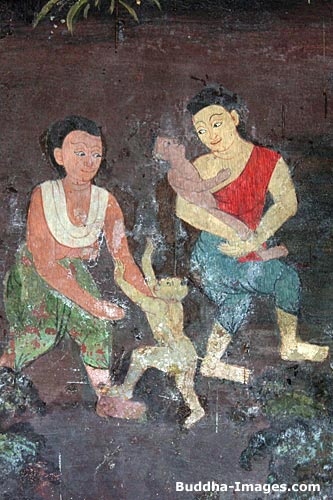 Scene from the Bhuridatta Jataka.
Scene from the Bhuridatta Jataka.
In the hidden depths of the earth, far below the fields and woodlands of the world of men, dwell the nagas. They are magical serpents who can assume human form when they wish. Their kingdom glitters with rare jewels and precious minerals as they live in great splendor and richness.
From time to time, they leave their realm and mingle with the human beings who inhabit the surface of the earth. The archenemy of the naga is the garuda, the great bird who lives in the sunlit and airy skies.
Once when a garuda was hungry he captured a naga and flew off with him. As he swept over the Himavat forest, clutching the head of the great snake in his claws, the naga was able to coil himself around a tall banyan tree. But the strength of the garuda was such that the tree was torn from its roots as he flew on. After he had devoured the naga, the garuda remembered that the banyan tree had sheltered the hut of a hermit, and he feared that his unwitting deed might bring misfortune upon himself. He returned to the hermit’s hut to ask him and was assured that he would suffer no ill on this account, for his action was not intended to harm. Pleased by this answer, the garuda rewarded the hermit by telling him the words of a magic snake charm of great power and gave him a fan behind which to chant it.
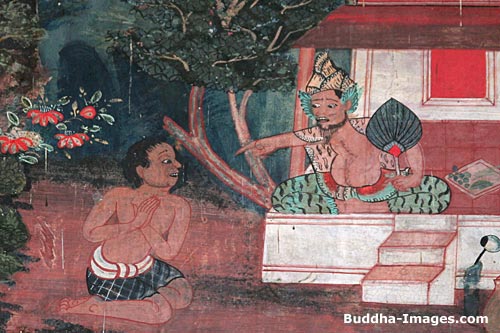 The Hermit, who has received a magic snake charm, and a fan behind which to chant it, has no reason to use the charm, and is about to give the powers to his servant Alambayana
The Hermit, who has received a magic snake charm, and a fan behind which to chant it, has no reason to use the charm, and is about to give the powers to his servant Alambayana
But as the hermit had no reason to use the charm, he gave it away to a Brahmin snake charmer named Alambayana who had been his faithful servant. Alambayana decided to use the charm to capture a mighty naga, which would earn him fame and wealth. He left the service of the hermit and wandered through the forest until he reached the banks of the Yamuna River. There he encountered a band of naga youths who had with them the precious jewel of the nagas, the “jewel that grants all desires.” As soon as they heard the Brahmin muttering the magic spell of the garuda, they trembled with fear and sank into the water, leaving the glittering gem behind. Alambayana, delighted with his good fortune, picked up the jewel, though unaware of its magic powers, and continued into the forest.
A little later, he met a hunter and his son who earned their livelihood by capturing wild animals in the forest. When the hunter spied the jewel in the hand of Alambayana, he recognized it and was filled with greed and regret, for once before he had had the opportunity to possess the gem but had not taken it. He thought back to that time many years before and recalled how he had heard the music and laughter of naga maidens at dawn one morning after he had spent a night in the forest. When he had crept close to discover the cause of the merriment, the maidens had spied him and fled, leaving behind a princely snake dressed in rich attire and coiled about a huge abandoned anthill. When the woodsman had approached him and asked who he might be, the prince had told him that he ,was Bhuridatta, prince of the nagas. He had earned the name Bhuridatta, or godly Datta, because of his wisdom and goodness. He had determined to increase his store of merit by leaving his wives and palace to live as an ascetic. He had found this abandoned anthill in the world of men, and every night he coiled his great length around it and remained there motionless until morning, vowing, “Let him who will take my skin or muscles or bones or blood.” At dawn, he had explained, ten naga maiden attendants would come to escort him back to the realm of the nagas.
Bhuridatta did not want anyone to know about his place of meditation. To keep the woodsman from revealing it, he had invited him and his son to return with him to the naga kingdom and dwell in splendor there. They had accepted and in the realm of the nagas had lived in great ease and luxury. However, after a year of such a life, the hunter had become restless and longed to return to the world of men. Bhuridatta, anxious for him to stay, had offered him great riches, even to the very same “jewel that grants all desires,” but the woodsman had refused them, saying that he wished to become an ascetic like Bhuridatta. Thus he and his son had returned to their former dwelling. When his wife learned, however, that he had decided to become a hermit and leave her again, she angrily told him that he must stay and help her support their family. So he had resumed his former life, a humble hunter as before.
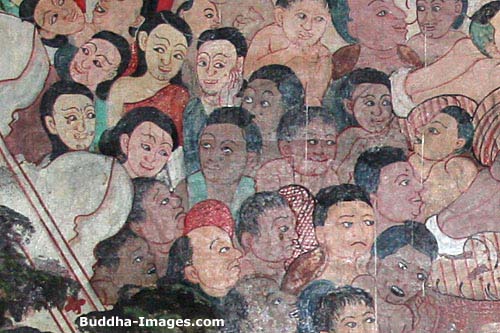 The Bhuridatta Jataka -
The Bhuridatta Jataka -
Onlookers at the Scene of the Naga Prince performing (read further). In the middle below, a probable foreigner is depicted
Now when he saw the magic jewel in the hand of the Brahmin Alambayana, he regretted not having accepted it when Bhuridatta had offered it to him and determined to have it. First he tried to persuade Alambayana that the gem was dangerous, but the wily Brahmin could not be convinced to part with it. Then Alambayana spoke of the purpose of his wanderings : to find and capture a mighty naga, which would win him fame and fortune. To anyone who could inform him of the whereabouts of such a snake he would give the glittering gem, whose powers he still did not realize.
The hunter saw in a flash how he could regain the wealth he had once given up. When he was about to tell Alambayana where the naga prince was hidden, his son tried to dissuade him from betraying his friend, who had trusted him to keep his secret and who had welcomed the hunter to his palace for a year. He urged his father to ask the naga prince himself for whatever riches he wanted, for he was certain that the naga would grant them.
But the greedy woodsman would not listen to his son’s wise counsel and led Alambayana through the forest to the great anthill around which Bhuridatta was coiled. Anxious to capture the great serpent, Alambayana hastily handed the hunter his reward, the magic jewel. But as the hunter grabbed it eagerly, it slipped through his fingers and disappeared through a crack in the earth, to be reclaimed by the naga world whence it came. The foolish woodsman departed, lamenting his misfortune.
Alambayana, intent upon his evil deed, approached Bhuridatta, chanting the magic spell and waving the fan, and captured him with ease. The Bodhisatta, for such was Bhuridatta, submitted, obeying the precept he had set for himself: “Let him who will take my skin or muscles or bones or blood.” Alambayana then crushed his bones and forced him into a basket. Although the naga prince suffered great pain, he permitted himself to feel no anger toward the Brahmin.
Alambayana took his prisoner to a nearby village and ordered him to perform. Unaffected by his cruel treatment, the great snake danced, assuming various colors and forms, spitting forth water and smoke, and causing great wonder among the villagers. The Brahmin profited greatly from Bhuridatta’s astonishing talents, for the people gave him much money to see the snake perform. He went from village to village, amassing great wealth and renown, until at last he reached Benares.
Meanwhile, the wives and mother of Bhuridatta had missed him and sent his brothers to seek him. One brother went to search in the kingdom of the gods, one looked in the Himavat forest, and the eldest, Sudassana, searched in the world of men. Dressed as an ascetic, he was accompanied by Bhuridatta’s favorite sister, who had disguised herself as a frog hidden in Sudassana’s matted hair.
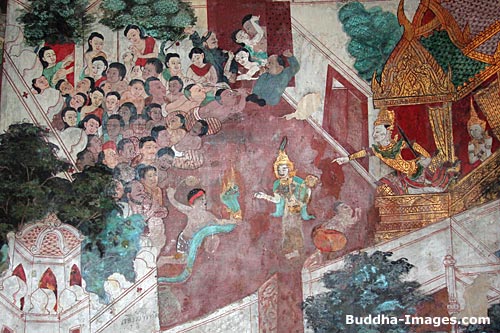
The Bhuridatta Jataka -
Alambayana makes the Naga Prince perform before the King of Benares.
See enlarged version of this image.
He searched the world of men in vain until finally he came to the city of Benares, where his mother’s brother was now king. He arrived just as the people were gathering in the marketplace to watch the great snake perform. Bhuridatta lifted his head out of his basket and saw his brother in the crowd. He went to him, and placing his head on his brother’s foot, he wept, and Sudassana wept also. Alambayana, seeing this from a distance, wondered if the snake had bitten the ascetic and assured Sudassana that his snake was not poisonous.
Sudassana answered proudly that no venom from a snake or any other creature could harm him. This retort made Alambayana angry and he challenged Sudassana to show his powers. The ascetic called forth his sister, who, in her form as a frog, contained a most poisonous venom. He asked her to spit three drops of her poison into his hand. Then he threatened Alambayana with these words: “Who sees these drops of poison waiting in my palm? Once they touch the ground, they have the power to blow up all of this city of Benares. Shall I show you?”
Alambayana shrank back, and the people cried out in fear. Only the king remained calm. He asked, “How can this poison be destroyed?”
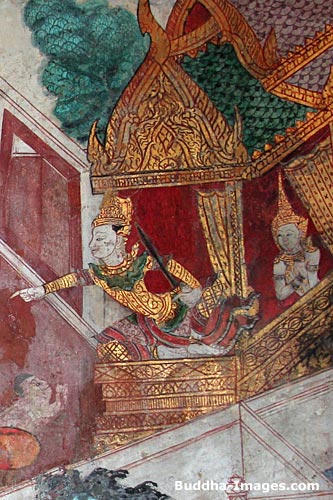 The Bhuridatta Jataka -
The Bhuridatta Jataka -
The King of Benares points to the spectacle in front of him.
Sudassana told him that the only way was to dig three enormous pits and to fill one with drugs, one with cow dung, and one with medicine. When this was done, he threw the three drops of poison into the three holes. They immediately exploded, filling the air with heat and thunder. The terrified Alambayana became as white as a leper, and he said three times, “I will set the naga prince free.”
Whereupon Bhuridatta emerged from the jeweled basket and, assuming a radiant form, stood before the multitude in all his glory. The evil Brahmin crept away and was not seen again. The two brothers revealed themselves to the king as his nephews, and there was a great celebration before they returned to the naga kingdom.
At the end of his life, Bhuridatta, having succeeded in keeping the precepts, ascended to heaven with the hosts of virtuous nagas.
http://www.buddha-images.com/khandahala-jataka.asp
Khandahala Jataka - Canda-Kumara, the honorable Prince
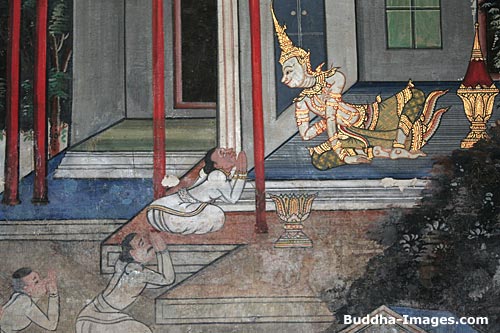 Scene from the Canda-Kumara Jataka
Scene from the Canda-Kumara Jataka
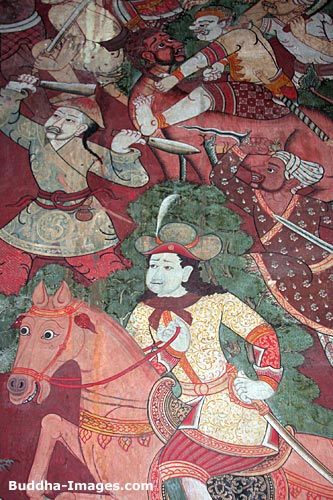
Foreigners (Westerners and Chinese) are depicted in scenes of the Canda-Kumara Jataka.
Now, it happened one day that Prince Canda was able to reverse a judgment that Khandahala had made in one case, and thereby restored some unjustly seized properties to their rightful owners. The news of this good deed spread to the people and they began to sing the praises of Prince Canda. They called on him continually to act as their mediator, and eventually the king conferred upon his son the office of judge. Khandahala grew more and more jealous of Prince Canda. He plotted innumerable ways to get rid of the young prince who had replaced him in the people’s affections. He planned a revenge that he thought would encompass the prince as well as the whole community, which had ceased to pay attention to him. Before long, he was able to put his scheme into execution.
One night, King Ekaraja dreamed of a glorious bejeweled heaven populated by celestial beings. When he awoke, he was seized by an overpowering desire to enter this radiant world. Having little religious insight himself, he went out onto the porch of his royal hall and bade his chief Brahmin to come to him. Still dazzled by his vision, he asked Khandahala to tell him the way to this resplendent abode. Khandahala saw that this was his moment for revenge. As he knelt before the king , he said, “It will not be easy for you to find this realm, and it will cost you dearly. You must offer a splendid sacrifice to the gods. It must be made in units of four. Only such a gift can win the attention of those on high. Sons, queens, merchants, beasts, these four kinds, sacrificed with proper ritual, will gain you entrance into this heaven.”
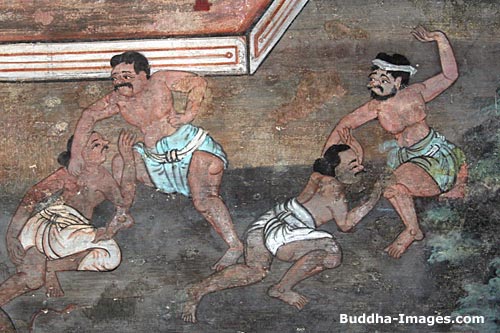 The Canda-Kumara Jataka - Victims are rounded up for the great sacrifice.
The Canda-Kumara Jataka - Victims are rounded up for the great sacrifice.
So greatly had the king’s dream affected him that he was no longer sound of mind. As a result he succumbed to Khandahala’s dreadful advice. He gave orders straightaway to prepare for a massive sacrifice outside the city walls. But Prince Canda soon divined the evil Brahmin’s motives and grieved that so many should have to lose their lives on his account. He asked his father to forgo the sacrifice, not to save himself, for he was willing to die, but for the sake of the innocent victims. A great sadness hung over the city, and one by one those close to King Ekaraja came and told him that the Brahmin spoke falsely. His aged parents pleaded with him to put an end to the plans for this bloody ordeal. But the power of the Brahmin was such that the king paid no heed. His ministers, his son’s wife, and even his little grandson begged that this appalling sacrifice not be carried out. Each time the king appeared to falter in his resolve, Khandahala rushed in to remind him that this was the only way to heaven. Wailing filled the city. Once the king weakened and released the hapless victims, only to call them back into custody under renewed pressure from the evil priest.
At last all was ready : the ground was cleared and a platform raised. The pyre was draped, and the banners were hung. Multi-tiered umbrellas marked the significance of the place. Horses and bulls, unaware of impending death, strained and snorted at their stakes, impatient for release. Canda sat apart from his fellow victims, but all awaited the same fate. Amid the company of the mourners assembled was Prince Canda’s wife. Realizing that the king would forever be deaf to her appeals, she called upon the gods. Clasping her hands as she walked, she beseeched the gods to heed her. “We on earth,” she said, “can do no more. It is clear that even the spirits here are blind to justice or else in league with falsity and guile. I therefore raise my plea to you on high to end this sacrifice forthwith before the innocent fall dead on these defiled grounds.”
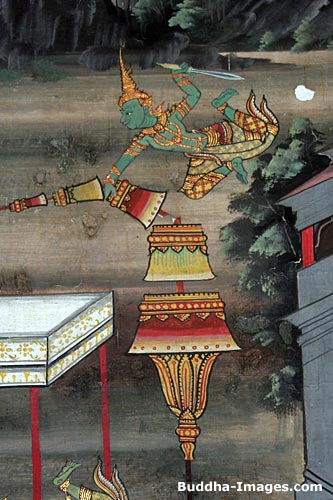 Sakka strikes and destroyes the Royal Umbrellas.
Sakka strikes and destroyes the Royal Umbrellas.
Suddenly, like a thunderbolt, mighty Sakka appeared overhead. Surrounded by a flaming aureole, he brandished a mallet and chisel with which he struck at the royal umbrellas. As they fell under the blows the sacrifice was terminated, for without the umbrellas the ceremony was no longer sacred. At this amazing sight the crowd broke into joyous tumult, while the victims danced in a wild frenzy. The animals whinnied and roared in fright and broke their chains. People were crushed beneath the stampeding herd. The king swiftly mounted his elephant but had no place to turn. The crowd set upon the evil Brahmin and beat him to death. They would have killed the king as well, if Sakka had not restrained them for the sake of Prince Canda. He was, however, sent into exile and made to live as an outcast, though his son never forgot him and saw to his needs. Gods and goddesses joined the people in the great festive occasion that was Prince Canda’s coronation. As king, he continued to be just and self-restrained, and his reign was long and peaceful, ever worthy of a future Buddha.
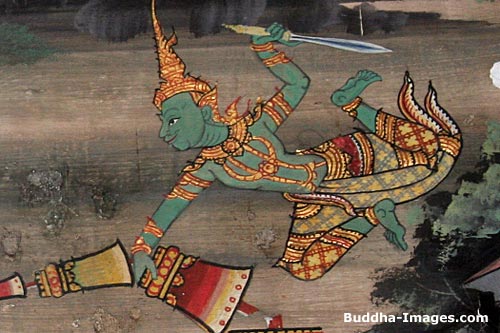 Sakka destroyes the Royal Umbrellas - the Canda-Kumara Jataka
Sakka destroyes the Royal Umbrellas - the Canda-Kumara Jataka
http://www.buddha-images.com/narada-jataka.asp
Narada Jataka - Narada, the great Brahma
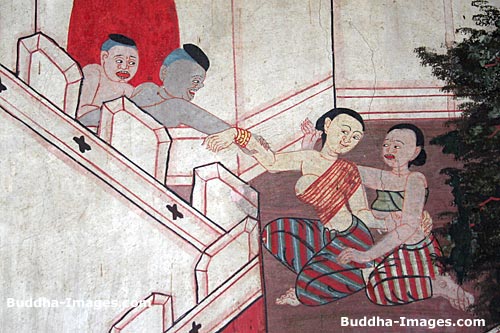 Scene in the courtyard of the palace of King Andati - the Narada Jataka.
Scene in the courtyard of the palace of King Andati - the Narada Jataka.
In the Kingdom of Videha, there lived King Angati and his beautiful daughter, Ruja. Ruja was his greatest joy, for though he had sixteen thousand wives, she was his only child. Upon her he lavished his wealth, sending her baskets of flowers, delicate trinkets, and garments of spun gold and silver. He even entrusted to her the honor of distributing every two weeks a thousand pieces of gold to the poor and sickly. This almsgiving won him the love of his people and the admiration of his daughter.
On the eve of the great festival of the full moon, King Angati, freshly bathed and dressed, stood with his three chief advisers surveying from his terrace the white city beneath him. As the streets gleamed with the rays of the advancing moon, the king turned to his counselors and asked, “How best shall we amuse ourselves on this festival eve?”
The first one, General Alata, suggested conquering new lands. The second, who was in charge of the king’s diversions, thought only of feasting and dancing. The third, the chief court Brahmin, knew of a naked ascetic living in the forest just outside the city and felt that it would be most entertaining to go seek out his advice. Since King Angati had always enjoyed listening to ascetics, he agreed to the Brahmin’s suggestion.
Thus the royal chariot, made of solid ivory, was polished and covered with silver ornaments for the king’s nocturnal journey. White were the four swift horses that drew it, white was the seven-tiered umbrella, white the royal fan. From a distance, the king in his shining chariot could have been a shaft of moonlight.
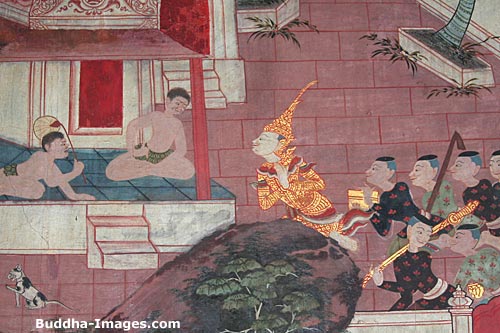 Scene from the Narada Jataka. (most likely) King Andata asking the advice of the heretic ascetic Guna.
Scene from the Narada Jataka. (most likely) King Andata asking the advice of the heretic ascetic Guna.
As he and his entourage approached the center of the forest, they saw a crowd surrounding a naked man seated on the ground and knew this must be Guna the ascetic. Not wanting to disturb the gathering, the king alighted from the chariot and greeted Guna on foot. After exchanging respectful words with him, King Angati seated himself at one side on a small mat covered with squirrel skins and told Guna the purpose of his visit. “The festival of the full moon is upon us,” he said, “and we have come to ask you to remove some doubts from our minds.”
He then proceeded to ask him the rules of right behavior toward parents and teachers, wives and children, Brahmins and the aged, the army and his people, adding, “And most important, we should like to know how it is that some men go to hell while others find their way to heaven.”
Now, it happened that at that time and in that land there was no true sage to whom men could turn for advice, and by default Guna, though merely an ignorant ascetic, childish and given to half-truths, had gained a reputation for wisdom. Thus when Guna seized this occasion to recite his heretical theories, many people believed him. He spoke in this way: “There is no right or wrong way to behave. Whatever you do, whether it be virtuous or evil, has no effect on your future, for your life is arranged in advance of your birth. Whether a man thrusts his sword into his enemy’s heart or whether he gives alms is irrelevant to a life over which we have no control. Hell? Heaven? Nonsense ! There is no other world than this. So follow your own will and seek your own pleasure.”
After Guna had finished his shocking speech, General Alata was the first to speak. “That confirms what I have always felt, for in a former birth I was a hunter, killing sacred cows and committing many wrongs. And yet do you see me suffer in this life? I am a prosperous general and have never been sent to hell.”
Then a slave dressed in rags tearfully related how he had always been and still was a virtuous man, never failing to give alms in previous lives. “But look upon me now,” he said, “a prostitute’s son, with hardly enough to eat, and still I give half of my food away to those as hungry as I, and still I keep the fast days. But my past and present virtues go unheeded, alas!”
King Angati, swayed by the stories he heard, spoke of his own unfailing devotion to almsgiving, but still he was not satisfied, saying, “Though I have not suffered as a result of my good deeds, I have not had a bit of enjoyment from them either.” And convinced of the truth of Guna’s words, he abruptly turned from the ascetic and, without saluting him, departed.
From then on, he resolved to make no further effort to do good. He relinquished all cares and unpleasant kingly duties to his advisers. He no longer made decisions. He busied himself only with watching others at work and at play. Since nothing he did was to have any consequences, he reasoned, he would have no more to do with the business of life. Worst of all, he stopped giving alms.
A month passed, and his subjects lamented the loss of their king’s interest in them. Ruja wept for her father, for she heard the mourning of his unhappy people and saw him harden his heart and close his ears to reason.
On the next festival of the full moon, Ruja dressed herself in her finest garments, gifts from her father, and entered his court. When he inquired how she was enjoying life, she answered that she lacked only one thing. She explained: “Tomorrow, my father, is the sacred fifteenth day. Please order, if you will, your courtiers to bring me a thousand pieces of gold that I may bestow them at once upon the people, as has been your custom.”
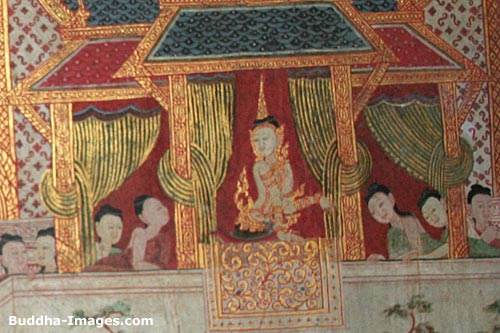 Ruja, the daughter of King Angati, tells the people that she has no alms to give to them.
Ruja, the daughter of King Angati, tells the people that she has no alms to give to them.
Her father replied indifferently, “Alms? Give away our gold? I have no wish to carry on such a foolish custom. Destiny makes us what we are. For what reason should I waste my wealth? Please do not annoy me further with such inconsequential matters, my daughter.”
Ruja realized with horror that her father had truly strayed from the holy precepts. She pleaded with him thus: “O my father, I have heard that he who listens to fools himself becomes a fool and that he who lets himself be led by children himself becomes a child. I fear that Guna’s words have turned you into such a person. As for your prosperous General Alata, he is merely reaping the good from past acts of merit, but it will soon be used up and he will go straight to hell. The beggar who ranted to you of his sufferings must be making up for some grave misdemeanor in his past and will soon come to the end of his misery. The good he is doing now, along with his accumulated merit, will bring him to know the joys of heaven.”
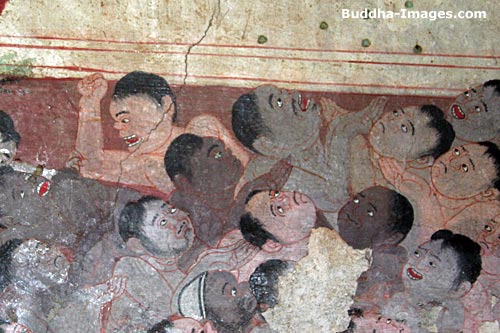 The people listening to Ruja, all poorly dressed and eager to receive alms, show their emotions.
The people listening to Ruja, all poorly dressed and eager to receive alms, show their emotions.
Then Ruja related how she herself, seven births ago, was born as a blacksmith’s son who, with his wicked friends, used to corrupt other men’s wives. As a result, in succeeding lives Ruja had been born as a castrated goat, a monkey whose father had cruelly removed his son’s testicles, a eunuch, and other mutilated beings. Though the king still loved his daughter, he was unmoved by her arguments and refused to budge from his fixed opinions.
Ruja then stepped to one side of the court, knelt down, and with her hands together above her head, made reverences in ten directions to the highest deities, those in the Brahma heavens, begging them to give some sign which would shock her father out of his heresy.
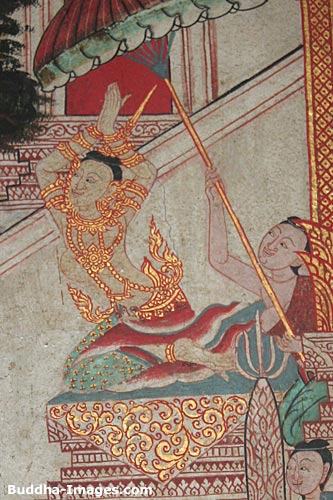 Ruja pleads the Gods for help, and shows reverence to the Bodhisatta Narada (outside of image), who descends from Brahma Heaven.
Ruja pleads the Gods for help, and shows reverence to the Bodhisatta Narada (outside of image), who descends from Brahma Heaven.
At that moment the Bodhisatta, whose name was Narada and who was the Great Brahma of that time, was looking earthward from his seat in his heaven. He happened to hear Ruja’s supplications and decided to help her. Before taking the journey to earth, he thought to himself, “There is none other than I who can drive away false doctrines. I shall go to the king in some unusual garb so that first my appearance and then my words will arrest his attention. King Angati values ascetics. I will dress like the most striking of them, and when he sees me, he will listen well.”
The four-faced Great Brahma dressed according to his word, in a red-mottled garment with a black antelope skin over one shoulder. He carried a golden pole on his shoulders from which two golden begging bowls were suspended by strings of pearls. His hair was matted as is the custom of ascetics, but with a golden needle tucked inside. Thus arrayed, he sped through the sky like the moon when the clouds race past it on a windy night, and stood suspended in the air before the king and his court.
Ruja, who had returned to the king’s side, immediately recognized the Brahma and bowed down to pay reverence to him. But the king, alarmed by the heavenly presence, rushed down from his throne to cry, “Who are you? From where do you come?”
Narada answered in this solemn way: “I am the Great Brahma from the Brahma heavens. I have come to tell you, King Angati, that you are condemning yourself to hell.”
“I say there is no heaven or hell,” Angati boasted. “To prove it, lend me five hundred pieces of gold, and if I am wrong, I will return one thousand pieces to you from hell when I am there.”
Narada warned him in this way: “If you were a virtuous man, I would gladly lend you gold, for it is not hard to collect a debt from a man in heaven. But men like you, denying the precepts, following false doctrines, are bound for hell, and when you hear what I will tell you about hell, you will see that no one would dare collect a debt from a man in such a place. There is not just one hell, but a thousand hells. Animals of all sizes will chew on your skin and bite at your bones. Flocks of ravens, crows, and vultures will prey upon you. Dogs with iron teeth will tear at your entrails. Hot winds, razor-edged mountains, burning coals, and sword-leafed trees will torture you.”
At last Angati was moved and trembled with fear. He looked to the Bodhisatta for help and asked him humbly how he could uncloud his mind and regain his senses. Narada then told him that while he was king and in good health, he should assume the responsibilities of his realm, providing for the poor, the hungry, the aged, and the Brahmins. “Let your mind guide your body, making you a sure but self-restrained man,” he said. “Only then will you find the path to heaven. Let your daughter teach you, for she has learned the right way.”
King Angati begged forgiveness and, with his daughter, bowed in reverence and gratitude to the Bodhisatta, who then turned and sped back to the Brahma world.
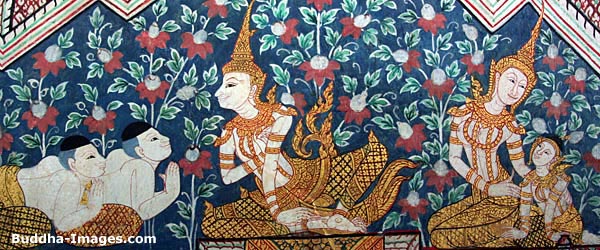
Mahanarada Kassapa Jataka
Mahanarada Kassapa Jataka is the story of a King who indulges himself in worldly pleasures. With the help of his morally conscious daughter (right on the painting) and the Boddhisatta Narada, the King is saved by his repentance. It depicts the virtue of Love and Kindliness, in having the power to convince people towards the Right Way of living.
Wat Kongkaram, Ratchaburi
http://www.buddha-images.com/vidhura-pandita-jataka.asp
Vidhura-Pandita Jataka - Vidhura-Pandita, the eloquent Sage
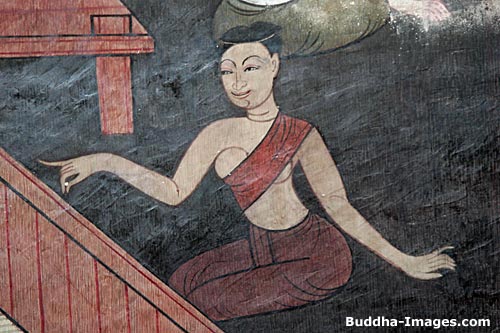 Scene from the Vidhura-Pandita Jataka, woman in courtyard.
Scene from the Vidhura-Pandita Jataka, woman in courtyard.
At one time , thousands of years ago, the Bodhisatta came to earth in the person of a sage named Vidhura-Pandita. He was no ordinary man of wisdom. His life’s purpose was to speak the truth, and in such a way that men would be held spellbound by his voice. As chief counselor to the righteous King Dhananjaya in the city of Indapatta, Vidhura fulfilled his mission well. His eloquent tongue had such power that one hundred and one kings from faraway lands, hypnotized by the sage’s sweet voice, were unable to return to their kingdoms.
He was known throughout many worlds. A naga queen, after hearing her husband describe the incomparable sage, longed to hear him speak. But it would have been unseemly for her, a mere female, to ask her husband to bring Vidhura to her. Instead, she feigned illness and took to her sickbed, moaning aloud that only one thing could cure her : the heart of Vidhura. “0 King, 0 Monarch of the Nagas,” she cried. “Bring me Vidhura’s heart or I shall die!”
The king was so distraught that his face became instantly old and withered, like a lotus touched by human hands. How could such a feat be accomplished? Who would have the mind and heart to carry out such a low deed? For though the king wished to save the life of his queen, he also knew the peerless qualities of the sage and mourned the need to command such an act. At that moment he caught sight of his beautiful daughter, Princess Irandati, and resolved to send her out to seek a husband who could wrest the heart from Vidhura.
The princess went off to the Himalayas to gather fragrant flowers of all colors. She adorned herself with them and made a bed of the most beautiful ones. She then began a seductive dance and sang, “What god or human, what gandhabba or sage, what naga or yakkha (yak), able to make all wishes come true, will marry me this very night?”
At that time a yakkha, or demon, named Punnaka was riding on his magic horse over the Black Mountain. Hearing Irandati’s love call, he stopped short, listened, and changed his course to ride over to her. Completely enamored, he resolved to marry her. Together they rode to the palace to ask her father’s permission to be joined in wedlock. The king secretly rejoiced that his plan was bearing fruit, but to Punnaka he sternly announced that he would agree to the marriage only on one condition : that Punnaka first obtain the flesh of the heart of Vidhura.
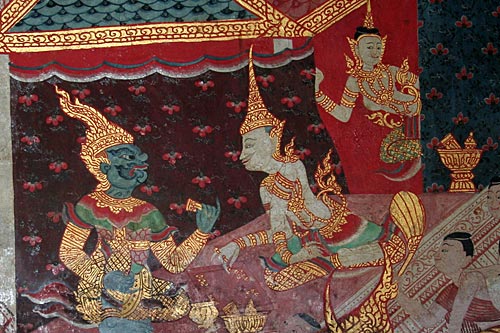 Punnaka, the Yak, plays the dice with King Dhananjaya. The King’s guardian is looking from behind a curtain.
Punnaka, the Yak, plays the dice with King Dhananjaya. The King’s guardian is looking from behind a curtain.
Pleased at the chance to prove his magical powers, Punnaka readily accepted the offer. His hair trimmed, his horse sparkling with jewels from ear to hoof, Punnaka, sumptuously dressed, rode off into the sky to Indapatta, the kingdom where Vidhura dwelled. Before he reached the city, he made up his mind to win the sage as his prize in a game of dice to which he would challenge King Dhananjaya. Once inside the city’s gates, he said, “0 mighty king, accept a game of dice with me, and if you win, a wondrous horse and magic gem will be yours.” Whereupon he demonstrated the supernatural power of his horse to walk on water, stand on the palm of his hand, fly in the air, and gallop along the narrow city wall. The yakkha then commanded his precious lapis lazuli to perform miracles, to create living things, other worlds, the sun, the moon, and the constellations. The king was so dazzled by Punnaka’s magic possessions that he accepted the game, saying that should he lose, “Except my body and my white umbrella, all that I have shall be yours.”
That was just what Punnaka wanted to hear, for he knew that he would use his magic to turn his opponent’s dice against him and win. The hall was readied, a central platform was cleared, and other kings were called in as witnesses. The dice board was set up, and the two sat down to play. Punnaka insisted that the king have the first play. The dice were thrown. But something strange was happening. The king could see the falling dice turn against him by some magic power. Now, this perplexed him, because whenever he engaged in play, his guardian deity, his mother in a previous existence, was always there to see that he won. This time, however, she could do no more than hover in a doorway behind the king and warn him before the dice fell that they were about to go against him. Heeding her advice, the first time the dice were thrown he deftly caught them and threw them again. A second time they fell against him.
It became evident that the goddess could no longer help him, because Punnaka’s magic was more powerful than hers. Moreover, when Punnaka noticed that the king was aware of the way the dice were turning, he recognized the existence of an opposing force. All at once he spied the guardian goddess behind the king. To end her power, he glared at her with a murderous look in his angry eyes. Alarmed, the delicate deity fled from the pinnacled roof to the top of a nearby mountain. From then on, Punnaka’s magic held sway, and the third time the king tossed the dice, he let them fall and lost. The yakkha then took his turn and won. Punnaka, gleeful in victory, clapped his hands and called for his payment : the sage Vidhura. The king was jolted. “Vidhura? My most trusted counselor? My refuge and strength?” Punnaka was unrelenting. “Are you the king’s slave or his kinsman?” he rudely shouted at Vidhura, knowing well that Vidhura would answer in the most humble way. Vidhura agreed that he could be given away, and it was thus that he was delivered into the hands of the ill-intentioned yakkha.
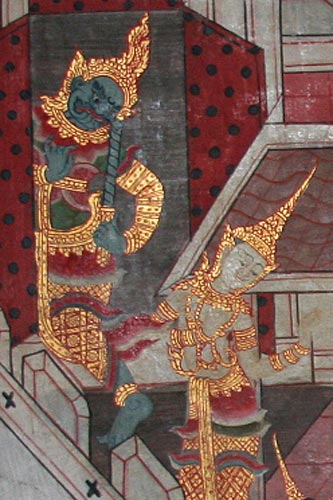 Vidhura is about to be taken away by the Yak Punnaka. He is taking leave from his family (not in picture).
Vidhura is about to be taken away by the Yak Punnaka. He is taking leave from his family (not in picture).
But first, Vidhura asked Punnaka’s permission to preach to his wives and sons. In keeping with his purpose on earth, he felt that he had to explain the principles of the doctrine before he could take leave of them. On the third day, he had completed what he had to say and calmly resigned himself to his unknown destiny. His wives, sons, servants, and friends all wept and prostrated themselves at his departure. Punnaka looked upon his victim and declared, “You are about to cross from life to death. A long journey awaits you. Take hold of the tail of my magic steed. You shall not see again the world of men.” The Bodhisatta answered resolutely, “I fear no being, for I have harmed no one, in mind or in speech or in deed. Therefore nothing can harm me.” Whereupon he pulled his garments about him and gripped the horse’s tail. In this way, they galloped across the sky to the Black Mountain. But contrary to Punnaka’s hopes, neither the rocks nor the trees there so much as brushed Vidhura, and when they reached the peak, his victim was still alive. Punnaka then tried to frighten Vidhura to death. He took on many shapes which would have made the most courageous of men swoon. Yet demons, lions, elephants, gigantic serpents, whirlwinds-all these terrifying forms failed to ruffle the calm of the Bodhisatta.
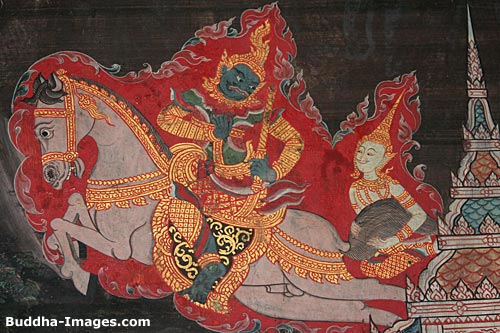 Vidhura holds on to the tail of the horse of the Yak Punnaka. However, despite a wild ride, he never gets hurt.
Vidhura holds on to the tail of the horse of the Yak Punnaka. However, despite a wild ride, he never gets hurt.
Punnaka, so expert at manipulating nature through trickery and disguise, realized that he could no longer resort to those means to kill his prisoner. He would have to use his own hand. In a flash, he seized the sage violently and, from where he stood at the summit of the mountain, whirled him around with his head downward facing the open expanse of the world. Dangling there, upside down to the earth, he, the embodiment of truth and wisdom, quietly addressed his executioner. “What is your reason for killing me?” When Punnaka told him why, the Bodhisatta immediately perceived that all concerned had misinterpreted the naga queen’s request for his heart. She had not meant his physical heart. It was the heart of his wisdom that she desired.
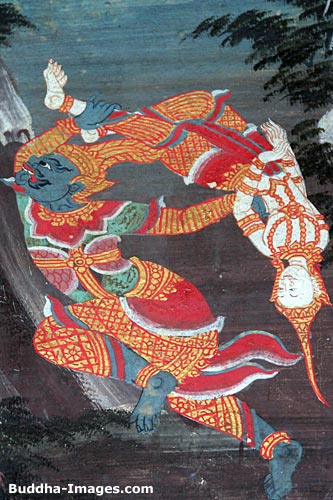 Pannaka, the Yak, whirles Vidhura (with his head down) around. Vidhura however, remains unperturbed
Pannaka, the Yak, whirles Vidhura (with his head down) around. Vidhura however, remains unperturbed
Vidhura was content, however, to say simply that if Punnaka would first listen to his teachings, he would then be willing to give up his heart to him. Punnaka placed him on the ground, and at that moment a richly decorated throne appeared beneath the sage. Punnaka listened at Vidhura’s feet, his hands joined in reverence. It was then that the giant became deeply conscious of his wrongdoing and was converted to the Right Way. He told his prisoner that he was a free man again. Rather than return immediately to his kingdom, however, the Bodhisatta asked to be taken to the naga kingdom in order to resolve the misunderstanding. Together they rode on Punnaka’s horse until the splendid naga palace came into sight, surrounded by the billowing sea and the strange creatures that inhabit it.
Once inside the court, Vidhura was seated on the central throne, surrounded by the naga king and queen, their daughter Irandati, and Punnaka. From this place of honor, he offered his listeners his wisdom and his heart. He no longer cared for his life, for he had already given of his teachings. But the naga king, having discovered that the heart of a sage is his wisdom, no longer desired the flesh of Vidhura’s heart. The naga queen, whose misunderstood words had led to this grave situation, dared not utter a word. All questions resolved, the king gave his daughter to the yakkha in marriage and ordered him to return the sage to the court of his king. Once more Punnaka called for his magic steed and, carrying Vidhura in front and his bride behind, rode off into the sky toward Indapatta, the sage’s home.
http://www.buddha-images.com/vessantara-jataka.asp
Vessantara Jataka
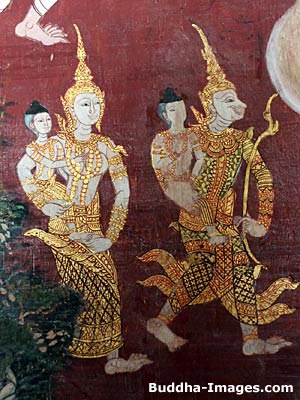 Scene from the Vessantara Jataka. This seems to be a very popular Jataka in Thailand. It depicts the life of prince Vessantara who gives away all his possessions, including his children to become servants of an evil spirited character. In the end everything turns out right though. This Jataka displays the virtue of Charity.
Scene from the Vessantara Jataka. This seems to be a very popular Jataka in Thailand. It depicts the life of prince Vessantara who gives away all his possessions, including his children to become servants of an evil spirited character. In the end everything turns out right though. This Jataka displays the virtue of Charity.
In the picture the prince and his wife take their children out of the palace to life in the forest.
Wat Kongkaram, Ratchabur
The time had come for Phusati, Sakka’s principal consort, to leave Tavatimsa heaven. On descending to earth, she became the mother of the Bodhisatta in his next-to-last birth. In her rebirth in the world of men she was still called Phusati and grew into a most beautiful young girl. At the age of sixteen she was wed to Sanjaya, king of Sivi, and they loved each other dearly. When she became aware that she was carrying a child, she had six alms halls built, from which she distributed silver daily. As the birth of her child grew imminent, she expressed the wish to visit every part of her husband’s capital city. The king granted her request and had a lying-in shelter made ready to follow her. On approaching the Vessa, or merchant sector, her labor began. Behind the shelter she gave birth to a son. Having taken his first breath of air from the commercial quarter, the newborn child was named Vessantara, though he possessed none of the avarice of a merchant. For at that time a miracle occurred : the baby spoke to say, “Mother, what gift can I make?” causing the gods in heaven to take notice of this Great Being.
When he was eight years old, the boy expressed the desire to be able to give away something of his very own, something that had not been given him by another. He said, “If someone should ask me for my heart, I would give it to him, or my eye, or my flesh.” This unusual wish attracted the attention of the gods, so that the earth quaked and thunder rumbled in the clouds over the Himavat. As a youth, Vessantara contented himself with giving away readily and frequently the things he had acquired. At sixteen, his formal studies completed, the kingdom was given over to him and a marriage arranged between the king-to-be and Princess Maddi, daughter of a neighboring king.
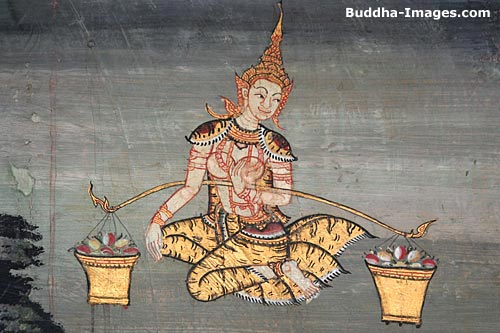 Maddi, Vessantara’s wife, collects food in the forest (see below).
Maddi, Vessantara’s wife, collects food in the forest (see below).
The kingdom prospered, and their marriage was happy. A son, Jali, and a daughter, Kanhajina, were born to them. Years before, when Vessantara was a baby, a young white elephant had been brought to the royal stables. The two princely beings grew up together. It was on this white elephant that Vessantara visited his mother’s alms halls six times a month to distribute gold. Indeed, many of his subjects attributed the prosperity of the kingdom and the benign rains that watered the fields to the virtue of the white elephant.
At this time the nearby kingdom of Kalinga was suffering from a prolonged drought. All the prayers of its people, all the supplications and offerings of its king were to no avail. Many in the kingdom had heard of the great white elephant and of Vessantara’s generosity. They suggested that the king send eight Brahmin emissaries to ask Vessantara for the favored creature. The king agreed. When the Brahmins arrived at Sivi, King Vessantara was distributing alms from the elephant. The valuable beast was covered with precious gems and other trappings of great worth. But on hearing their request, the king granted it immediately, pouring water into their hands to indicate the gift, so great was his desire to be charitable. When the gods saw this noble act, the earth shook and the skies were filled with thunder and lightning.
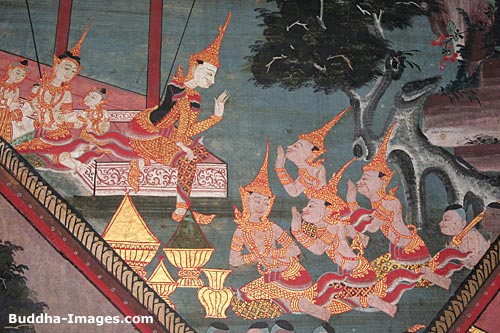 Vessantara, Maddi and their children, with attendants at the palace. [probable]
Vessantara, Maddi and their children, with attendants at the palace. [probable]
The citizens of Vessantara’s kingdom were so distressed by the loss of the great animal that had brought them prosperity that they forced King Sanjaya to resume control of the kingdom and banish Vessantara. His parents were heartbroken, but the people’s fury was so great that he was granted only one day’s grace before exile. On that day Vessantara gave away all his possessions, seven hundred of each kind : elephants, horses, chariots, maidens, slaves, and many others. This was known as the Gift of the Seven Hundreds. People came from far away, each to receive a gift. Vessantara was still distributing them when night fell. Then, with his wife and children, who would not be left behind, he spent his last night taking leave of his parents. The banished family left the city at sunrise in a chariot drawn by four horses. No sooner had the city gates closed behind them than they met four Brahmins. Having arrived too late for the Gift of the Seven Hundreds, the Brahmins now asked for the four horses, which were promptly granted them. The gods dispatched four deities in the form of stags to draw the chariot.
However, shortly thereafter a fifth Brahmin appeared, asking for the chariot. Vessantara agreed gladly, the stags disappeared, and the noble prince and his wife continued on their way by foot, the boy in his father’s arms, the girl in her mother’s. Their journey took them first to Ceta, a city ruled by Vessantara’s uncle, where they rested for a day and a night in a hall beside the city gates, for they were unwilling to enter the city, although the king had invited them to rule in his stead. When they left the city the king of Ceta accompanied them to the nearby forest, leaving them with a woodsman who guided them as far as the river. There they rested and were given food. They then set out alone into the foothills of the Himalayas, skirting the shores of the great Mucalinda Lake, and at last they reached the mountains. A narrow path took them through a forest to the foot of Mount Vamka.
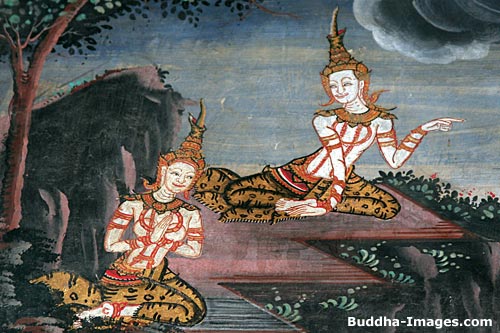 Vessantara and his wife Maddi live as hermits in the forest. [the clothing, with leopard skin type garments, indicates that they are hermits]
Vessantara and his wife Maddi live as hermits in the forest. [the clothing, with leopard skin type garments, indicates that they are hermits]
Sakka, the king of the gods, anticipating their arrival, had ordered his architect Vissakamma to construct two hermitages beside a lotus pond. Vessantara went ahead. On entering one of the buildings alone, he found four sets of ascetic’s robes neatly folded and knew that Sakka was observing him. He dressed, took the vows of an ascetic, then went out to greet his wife Maddi. She and the children followed his example. They lived in separate huts by the pond for seven months, eating the roots and jungle fruits which Maddi collected each day. Although Maddi looked after her husband, they never so much as touched each other, for both had sworn chastity. Meanwhile, in Kalinga the drought had broken with the arrival of the white elephant. In a village there, lived a poor Brahmin, Jujaka by name, who had a beautiful young wife. When she went to the well for water, she was frequently reviled and teased by the village women for caring so well for her old and ugly husband. At last she refused to go to the well any longer. She insisted that Jujaka find her some servants in order to spare her ridicule.
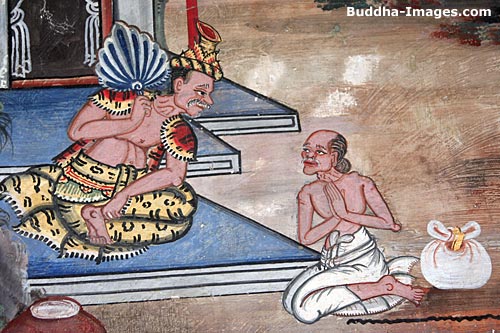 Jujaka (right), on the way to ask Vessantara for his children, asks for direction from forest hermit
Jujaka (right), on the way to ask Vessantara for his children, asks for direction from forest hermit
Having heard of Vessantara’s fabled generosity, she suggested that Jujaka seek him out and ask him for his two children to serve her. As Jujaka was penniless and unable to buy slaves, he set out to find Vessantara. While passing through the forest near Ceta, he was attacked by watchdogs kept there by the king to prevent people from seeking out Vessantara. By saying that he had been sent by King Sanjaya to bring Vessantara back, Jujaka was able to trick the dogs’ keeper, a huntsman, into letting him pass. He repeated the same story to a forest hermit, who reluctantly directed him to Vessantara’s hermitage. Jujaka waited until Maddi had departed into the forest the next morning before he approached the hermitage. As soon as Vessantara caught sight of the old man he was overjoyed, for he knew that at last he had an opportunity to make a supreme gift.
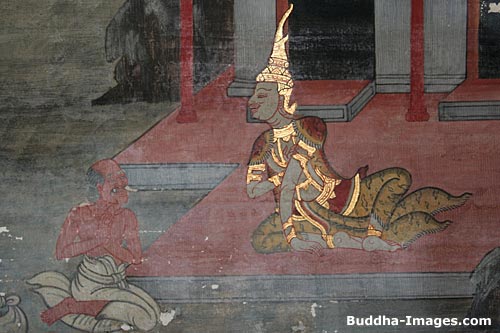 Jujaka, the old man, asks Vessantara to give his children to be his servants.
Jujaka, the old man, asks Vessantara to give his children to be his servants.
As Jujaka made his unusual request, Vessantara agreed to give away his two beloved children. When the children overheard their exchange of words, they ran away to hide under the broad leaves of the lotus plants in the pond. Soon their father found them and called them back. He presented them to Jujaka by pouring water over his outstretched hands. The gods were disturbed, the earth quaked, and there was a great tumult in the heavens. The Brahmin bound the children’s hands with a jungle creeper, whipping them on their way. Tears streamed from Vessantara’s eyes, and he went into his hut weeping. When he realized that the cause of his grief was his affection for his children, he set his mind on nonattachment and soon regained the calm of an ascetic.
As Jujaka drove the wailing children through the forest, the gods thought what anguish Maddi would suffer if she should see them thus. Three of the deities took the forms of a lion, a tiger, and a leopard that blocked the path of Maddi, thus preventing her return to the hermitage until after night had fallen. Vessantara could not bring himself to tell her what had become of the children. The distraught mother searched for them until dawn. When morning came, she returned to her hut and collapsed in a faint. Vessantara was in great distress. Breaking his ascetic’s vows, he raised his wife up, then rubbed her face and bosom with water to revive her. When she was restored, he told her of his gift of the children. Understanding his desire to give away all he possessed, she did not protest. Instead, she rejoiced in his opportunity to make a supreme gift in his effort to achieve omniscience.
There remained one last and greatest gift, a devoted wife, and Sakka in his wisdom knew that Vessantara would not withhold it. To keep Vessantara from giving Maddi away to anyone else, Sakka assumed the guise of a Brahmin and approached the hermitage that same morning. Only then did Vessantara realize that he must also give away his dear wife to attain his goal. He gave her willingly to the old Brahmin, pouring water over his hands. Maddi submitted without a word, knowing that this would fulfill her husband’s greatest wish : to have perfect knowledge. The heavens shook, the oceans roared, and the gods acknowledged that Vessantara had truly achieved omniscience. Then, having seen that the Great Being was capable of supreme charity, Sakka returned Maddi to him.
Meanwhile, Jujaka was lost in the forest. At night while he slept in the branches of a tree, he left the children bound to the trunk. However, deities took the shapes of their parents to nurture and protect them. The gods also guided the path of Jujaka so that although he intended to return to Kalinga, he and the children soon found themselves in Sivi. There the children were recognized and brought before King Sanjaya along with their captor. The king was so overjoyed at finding his grandchildren that he did not punish Jujaka. Instead, he paid the Brahmin a great ransom, with which the old man built himself a splendid mansion. There he lived sumptuously, but unaccustomed to such richness, he overate and died. King Sanjaya questioned the children about their parents and was told that they were alive and well. But Jali reproached his grandfather for sending Vessantara away, accusing the king of not loving his son enough. Whereupon King Sanjaya determined to go to Mount Vamka in order to bring the royal couple back to Sivi. To this end he ordered the road to be made smooth and wide, so that chariots could move along it. He ordered his generals thus: “Prepare my armies, elephants, horses, chariots, and banners, to make a royal procession to fetch my son back to Sivi. The road must be strung with garlands and offerings, with plenty of food and wine to assuage the hunger and thirst of the travelers. Let there be music and singing as we proceed.”
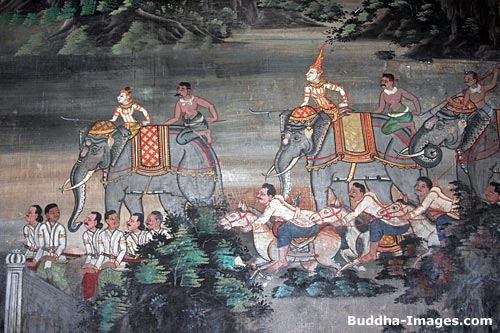 King Sanjaya and his wife Phusati, set out to visit Vessantara and his wife Maddi, and to bring them back to rule the Kingdom.
King Sanjaya and his wife Phusati, set out to visit Vessantara and his wife Maddi, and to bring them back to rule the Kingdom.
When all was prepared, the great host set off for Mount Vamka, the king and Jali leading the way. They moved across the plains, into the forest, and around Mucalinda Lake, at last reaching the foot of the mountains. All this while, Vessantara and Maddi had lived peacefully at the hermitage. As King Sanjaya’s procession approached, Vessantara could hear the noise of marching armies, elephants, and chariots. At first he was alarmed, thinking that they were enemies come to take his life. He and Maddi climbed a nearby hill to survey the scene. Maddi, recognizing the banners as those of Sivi, reassured him, and they returned to the hermitage. King Sanjaya approached them first and gravely inquired after their welfare. Assured of their well-being, he called his wife, Phusati, and the children to join them. So great was their joy at being reunited that all fell weeping on the ground in a faint. The gods took pity, the earth shook, lightning flashed in the clouds, and from the skies fell a shower of heavenly rain that revived the royal family. King Sanjaya asked Vessantara to return to rule the kingdom, for the people, regretting his departure, wished him to be their king once more.
Vessantara, having given all, was willing to resume his kingly role. He put away his hermit’s robes. Three times he circled the hut, saying, “Here I have attained omniscience,” and prostrated himself before it. Then he was bathed, had his hair trimmed, and was dressed in princely garments, so that he shone with great splendor. Maddi was similarly arrayed in beautiful cloths and gems. Thus they proceeded to the camp of King Sanjaya. After a month of joyful festivities in the forest, they returned to Sivi with great pomp. King Vessantara mounted the throne and by Sakka’s will was endowed with treasures sufficient for distribution until the end of his life. After reigning gloriously for many years, the king passed away to Brahma’s heaven, to remain a symbol of generosity for all time.
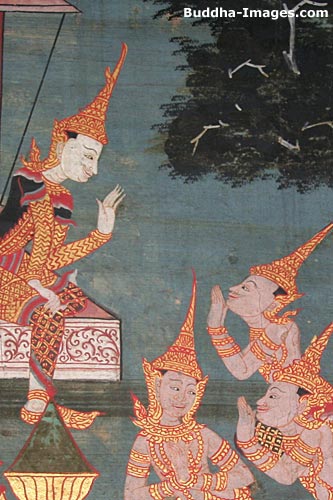 Vessantara and some attendants (detail for a picture above)
Vessantara and some attendants (detail for a picture above)
You can read and see another (and longer, with different illustrations) rendition of the Vessantara Jataka, as it is depicted on the Bun Phra Wet Painted Scrolls in Northeastern Thailand.
GOOD GOVERNANCE
Uttar Pradesh announces new land acquisition policy
In a bid to placate agitating farmers, Uttar Pradesh Chief Minister Mayawati Friday announced a new land acquisition policy which offers several sops to the people whose lands are acquired.
‘The UP (Uttar Pradesh) government has come out with the best land acquisition policy, which beats any other state in the country,’ state Cabinet Secretary Shashank Shekhar Singh said at a press conference here.
He said no land of farmers will be acquired without their express consent under the terms of a written agreement. ‘The price of the land will be finalised through a negotiated settlement between the government and the land-owner,’ he said.
‘In addition to a mutually settled price, we also propose to offer the farmer a handsome annuity at the rate of Rs.20,000 per acre for a period of 33 years, during which it would be given an annual hike at the rate of Rs.600 per acre. However, every affected farmer would also have the option to go for a one-time payment at the rate of Rs.2.40 lakh per acre,’ Singh said.
‘Besides, one member of the affected farmer’s family would be entitled to consolidated wages of Rs.1.85 lakh for a period of five years,’ he added.
Yet another sop was making it binding on the company for whom land were to be acquired to reserve 25 percent of its shares for affected farmers, who would have the choice to go or not to go for these.
‘Last but not the least, was allocation of 7 percent of the acquired land to let the affected farmers build homes for themselves,’ Singh said.
Singh said to resolve the crisis after last month’s police firing on demonstrating farmers at Tappal in Aligarh district, the state government has decided to drop its plan of setting up a high tech township along the proposed Yamuna Expressway passing through Tappal.
Trouble erupted at Tappal as farmers protested against what they termed as ‘grossly inadequate’ compensation for their lands acquired for the township.
‘We are not against land acquired for building the expressway, but if the government wants to take our land for private developers to build a high tech township where property will be sold at sky-rocketing prices, then we must be paid compensation at the same rate that was given to our counterparts in Greater Noida,’ farmers’ action committee leader Mahendra Singh Tewatia told IANS over telephone from Tappal.
Fortress Ayodhya for judgment day
The Mayawati government has turned eastern Uttar Pradesh into a security fortress weeks before the Allahabad High Court is to pronounce its verdict on the original title suit of the Ram Janmabhoomi-Babri Masjid case.
More than one lakh paramilitary and other security personnel are being deployed in Ayodhya and its adjoining districts stoking fear and apprehension in the minds of the warring parties.
The Vishwa Hindu Parishad (VHP) is jittery over the state government’s extensive plans to keep a close watch on the religious leaders of temple town.
The security net has left Muslim leaders terrified as well. Some leaders of the minority community have asked youngsters to avoid travelling in the sensitive areas.
The special Lucknow bench of the Allahabad High Court is expected to pronounce the judgment, arguably one of the most awaited in the history of independent India, in the middle of September.
While over 150 companies of the PAC (about 15,000 personnel) and more than 20,000 civil police have already been deployed in the area, police sources said that out of 458 companies of the central force which Mayawati has demanded from the Centre, 40 companies would be deployed in the twin towns of Ayodhya and Faizabad and the remaining in the eastern part of the state.
“There are already over 10,000 members of the Rapid Action Force, 10,000 PAC personnel and 5,000 civil police deployed in Ayodhya and Faizabad. And there would be at least 15,000 more securitymen in the temple town from mid- September.
“About 40,000 security personnel will cordon off Ayodhya and keep a watch on visitors entering and exiting the temple town. Roughly, over one lakh security forces would be deployed in Varanasi, Azamgarh, Basti, Gorakhpur and other districts of eastern Uttar Pradesh,” a police official said.
The official said that the Mayawati government is also in the process of setting up 11 temporary jails in Faizabad district and making arrangements for a prolonged deployment of the central forces.
Additional director-general of police Brijlal said: “We are making extensive arrangements to frustrate the designs of the troublemakers. We will not leave any scope for them to disturb the social harmony.” But Abdul Batin Nomanee, mufti of Varanasi said large- scale deployment of security forces and flag marches have frightened the Muslims. “Members of the community, particularly the young people, are cancelling their train reservations. We have asked Muslim youngsters to stay at home and not travel in September,” Nomanee said.
He added that the “panic like situation” has been created not only by the saffron parties, like the VHP, but also by the state government. “The government should have deployed security forces and intensified flagmarches in sensitive areas without announcing every now and then that some people could disturb the social harmony. It creates unnecessary tension,” he said.
The VHP, on the other hand, views the tough security measures as “a design of Mayawati to terrorise the society and divide them on religious line and then woo the Muslims for political mileage”. Ram Vilas Vedanti, a member of the Ram Janmabhoomi Trust (formed by the VHP leaders) and former BJP MP, claimed that Mayawati was resorting to hate politics in the name of maintaining law and order in the temple town.
“While we are telling the state government that there is nothing to worry about, Mayawati is trying to appease the Muslims by setting up intelligence agencies against us. It appears that she will not let any outsider enter Ayodhya,” Vedanti said.
His anger against the state didn’t stop there. “In fact Mayawati is preparing the ground to victimise us. She has given a large number of houses under the Kanshi Ram Urban Housing Scheme to Bangladeshi Muslims, without verifying their background. This will create hatred in the temple town.” Hashim Ansari, a plaintiff in the title suit, said apprehension was certainly there that “the enemies of peace” would try to create violence after the judgment.
“Who knows what is in the mind of those who always communalise the atmosphere here,” Ansari said.
For the record, Mayawati has held a series of meetings with senior police officers, administrative officers and also with her ministers, MPs, MLAs and zonal coordinators this week.
She has asked them to remain vigilant “against the nefarious designs” of opposition parties.
Maya accuses govt of misusing CBI
Uttar Pradesh Chief Minister Mayawati said that Centre was misusing the agency against her in the disproportionate assets case.
The BSP supremo charged the government of misusing the probe agency while addressing party leaders and workers at a meeting here, party sources revealed.
Mayawati questioned how CBI takes cognisance of the Income
Tax report in case of leaders like Samajwadi Party’s Mulayam Singh Yadav and RJD chief Lalu Prasad Yadav but when it comes to her it was trying to “frame” her in the DA case, BSP sources said.
She has cautioned BSP workers against any design or conspiracy by political opponents through several tactics like sting operations ahead of the polls.
Mayawati has also asked them to apprise the general public against any such move, sources said.
Farmers’ stir ends in Uttar Pradesh
Farmers in Uttar Pradesh today ended their over month-long stir against acquisition of land for a township under the Yamuna Expressway project at a village near here, a day after the state government decided to scrap the township plan.
The five-week old farmers’ agitation spearheaded by the Kisan Sangharsh Samiti ended here this evening after talks between agitating farmers and representatives of the state government, district magistrate Mr K Ravinder Naik said.
Referring to the precondition set by farmers earlier during the day that they would withdraw their agitation if cases lodged against about 100 odd peasants after the August 14 violence in the course of their stir were dropped, Naik said the demand had already been accepted by the state government earlier.
“The state government had already given a commitment on August 16 that all such cases will be dropped. Now, I have once again given an assurance that we will not go back on any of our commitments.”
At least 7 persons had been injured on August 14 when police opened fire on violent farmers who indulged in heavy brick-batting protesting against the alleged detention of one of their leaders during the course of the agitation.
When contacted, the leader of the Kisan Sangharsh Samitee Manbeer Singh Tewatia confirmed that the agitation had been called off following discussions with some senior district officials earlier this evening.
Uttar Pradesh government yesterday decided to scrap a township under Yamuna Expressway project at Tappal village near Aligarh in the face of an agitation by local farmers against acquisition of their land for the purpose.
|
Leave a Reply



















![[DSCN0337.jpg]](http://1.bp.blogspot.com/_WfpsDFzTM0A/SalqbtU3YaI/AAAAAAAACaQ/9rdSPFYG-Ws/s1600/DSCN0337.jpg)


























































